Get science-backed answers as you write with Paperpal's Research feature

How to Write an Essay Introduction (with Examples)

The introduction of an essay plays a critical role in engaging the reader and providing contextual information about the topic. It sets the stage for the rest of the essay, establishes the tone and style, and motivates the reader to continue reading.
Table of Contents
What is an essay introduction , what to include in an essay introduction, how to create an essay structure , step-by-step process for writing an essay introduction , how to write an introduction paragraph , how to write a hook for your essay , how to include background information , how to write a thesis statement .
- Argumentative Essay Introduction Example:
- Expository Essay Introduction Example
Literary Analysis Essay Introduction Example
Check and revise – checklist for essay introduction , key takeaways , frequently asked questions .
An introduction is the opening section of an essay, paper, or other written work. It introduces the topic and provides background information, context, and an overview of what the reader can expect from the rest of the work. 1 The key is to be concise and to the point, providing enough information to engage the reader without delving into excessive detail.
The essay introduction is crucial as it sets the tone for the entire piece and provides the reader with a roadmap of what to expect. Here are key elements to include in your essay introduction:
- Hook : Start with an attention-grabbing statement or question to engage the reader. This could be a surprising fact, a relevant quote, or a compelling anecdote.
- Background information : Provide context and background information to help the reader understand the topic. This can include historical information, definitions of key terms, or an overview of the current state of affairs related to your topic.
- Thesis statement : Clearly state your main argument or position on the topic. Your thesis should be concise and specific, providing a clear direction for your essay.
Before we get into how to write an essay introduction, we need to know how it is structured. The structure of an essay is crucial for organizing your thoughts and presenting them clearly and logically. It is divided as follows: 2
- Introduction: The introduction should grab the reader’s attention with a hook, provide context, and include a thesis statement that presents the main argument or purpose of the essay.
- Body: The body should consist of focused paragraphs that support your thesis statement using evidence and analysis. Each paragraph should concentrate on a single central idea or argument and provide evidence, examples, or analysis to back it up.
- Conclusion: The conclusion should summarize the main points and restate the thesis differently. End with a final statement that leaves a lasting impression on the reader. Avoid new information or arguments.

Here’s a step-by-step guide on how to write an essay introduction:
- Start with a Hook : Begin your introduction paragraph with an attention-grabbing statement, question, quote, or anecdote related to your topic. The hook should pique the reader’s interest and encourage them to continue reading.
- Provide Background Information : This helps the reader understand the relevance and importance of the topic.
- State Your Thesis Statement : The last sentence is the main argument or point of your essay. It should be clear, concise, and directly address the topic of your essay.
- Preview the Main Points : This gives the reader an idea of what to expect and how you will support your thesis.
- Keep it Concise and Clear : Avoid going into too much detail or including information not directly relevant to your topic.
- Revise : Revise your introduction after you’ve written the rest of your essay to ensure it aligns with your final argument.
Here’s an example of an essay introduction paragraph about the importance of education:
Education is often viewed as a fundamental human right and a key social and economic development driver. As Nelson Mandela once famously said, “Education is the most powerful weapon which you can use to change the world.” It is the key to unlocking a wide range of opportunities and benefits for individuals, societies, and nations. In today’s constantly evolving world, education has become even more critical. It has expanded beyond traditional classroom learning to include digital and remote learning, making education more accessible and convenient. This essay will delve into the importance of education in empowering individuals to achieve their dreams, improving societies by promoting social justice and equality, and driving economic growth by developing a skilled workforce and promoting innovation.
This introduction paragraph example includes a hook (the quote by Nelson Mandela), provides some background information on education, and states the thesis statement (the importance of education).
This is one of the key steps in how to write an essay introduction. Crafting a compelling hook is vital because it sets the tone for your entire essay and determines whether your readers will stay interested. A good hook draws the reader in and sets the stage for the rest of your essay.
- Avoid Dry Fact : Instead of simply stating a bland fact, try to make it engaging and relevant to your topic. For example, if you’re writing about the benefits of exercise, you could start with a startling statistic like, “Did you know that regular exercise can increase your lifespan by up to seven years?”
- Avoid Using a Dictionary Definition : While definitions can be informative, they’re not always the most captivating way to start an essay. Instead, try to use a quote, anecdote, or provocative question to pique the reader’s interest. For instance, if you’re writing about freedom, you could begin with a quote from a famous freedom fighter or philosopher.
- Do Not Just State a Fact That the Reader Already Knows : This ties back to the first point—your hook should surprise or intrigue the reader. For Here’s an introduction paragraph example, if you’re writing about climate change, you could start with a thought-provoking statement like, “Despite overwhelming evidence, many people still refuse to believe in the reality of climate change.”
Including background information in the introduction section of your essay is important to provide context and establish the relevance of your topic. When writing the background information, you can follow these steps:
- Start with a General Statement: Begin with a general statement about the topic and gradually narrow it down to your specific focus. For example, when discussing the impact of social media, you can begin by making a broad statement about social media and its widespread use in today’s society, as follows: “Social media has become an integral part of modern life, with billions of users worldwide.”
- Define Key Terms : Define any key terms or concepts that may be unfamiliar to your readers but are essential for understanding your argument.
- Provide Relevant Statistics: Use statistics or facts to highlight the significance of the issue you’re discussing. For instance, “According to a report by Statista, the number of social media users is expected to reach 4.41 billion by 2025.”
- Discuss the Evolution: Mention previous research or studies that have been conducted on the topic, especially those that are relevant to your argument. Mention key milestones or developments that have shaped its current impact. You can also outline some of the major effects of social media. For example, you can briefly describe how social media has evolved, including positives such as increased connectivity and issues like cyberbullying and privacy concerns.
- Transition to Your Thesis: Use the background information to lead into your thesis statement, which should clearly state the main argument or purpose of your essay. For example, “Given its pervasive influence, it is crucial to examine the impact of social media on mental health.”

A thesis statement is a concise summary of the main point or claim of an essay, research paper, or other type of academic writing. It appears near the end of the introduction. Here’s how to write a thesis statement:
- Identify the topic: Start by identifying the topic of your essay. For example, if your essay is about the importance of exercise for overall health, your topic is “exercise.”
- State your position: Next, state your position or claim about the topic. This is the main argument or point you want to make. For example, if you believe that regular exercise is crucial for maintaining good health, your position could be: “Regular exercise is essential for maintaining good health.”
- Support your position: Provide a brief overview of the reasons or evidence that support your position. These will be the main points of your essay. For example, if you’re writing an essay about the importance of exercise, you could mention the physical health benefits, mental health benefits, and the role of exercise in disease prevention.
- Make it specific: Ensure your thesis statement clearly states what you will discuss in your essay. For example, instead of saying, “Exercise is good for you,” you could say, “Regular exercise, including cardiovascular and strength training, can improve overall health and reduce the risk of chronic diseases.”
Examples of essay introduction
Here are examples of essay introductions for different types of essays:
Argumentative Essay Introduction Example:
Topic: Should the voting age be lowered to 16?
“The question of whether the voting age should be lowered to 16 has sparked nationwide debate. While some argue that 16-year-olds lack the requisite maturity and knowledge to make informed decisions, others argue that doing so would imbue young people with agency and give them a voice in shaping their future.”
Expository Essay Introduction Example
Topic: The benefits of regular exercise
“In today’s fast-paced world, the importance of regular exercise cannot be overstated. From improving physical health to boosting mental well-being, the benefits of exercise are numerous and far-reaching. This essay will examine the various advantages of regular exercise and provide tips on incorporating it into your daily routine.”
Text: “To Kill a Mockingbird” by Harper Lee
“Harper Lee’s novel, ‘To Kill a Mockingbird,’ is a timeless classic that explores themes of racism, injustice, and morality in the American South. Through the eyes of young Scout Finch, the reader is taken on a journey that challenges societal norms and forces characters to confront their prejudices. This essay will analyze the novel’s use of symbolism, character development, and narrative structure to uncover its deeper meaning and relevance to contemporary society.”
- Engaging and Relevant First Sentence : The opening sentence captures the reader’s attention and relates directly to the topic.
- Background Information : Enough background information is introduced to provide context for the thesis statement.
- Definition of Important Terms : Key terms or concepts that might be unfamiliar to the audience or are central to the argument are defined.
- Clear Thesis Statement : The thesis statement presents the main point or argument of the essay.
- Relevance to Main Body : Everything in the introduction directly relates to and sets up the discussion in the main body of the essay.

Writing a strong introduction is crucial for setting the tone and context of your essay. Here are the key takeaways for how to write essay introduction: 3
- Hook the Reader : Start with an engaging hook to grab the reader’s attention. This could be a compelling question, a surprising fact, a relevant quote, or an anecdote.
- Provide Background : Give a brief overview of the topic, setting the context and stage for the discussion.
- Thesis Statement : State your thesis, which is the main argument or point of your essay. It should be concise, clear, and specific.
- Preview the Structure : Outline the main points or arguments to help the reader understand the organization of your essay.
- Keep it Concise : Avoid including unnecessary details or information not directly related to your thesis.
- Revise and Edit : Revise your introduction to ensure clarity, coherence, and relevance. Check for grammar and spelling errors.
- Seek Feedback : Get feedback from peers or instructors to improve your introduction further.
The purpose of an essay introduction is to give an overview of the topic, context, and main ideas of the essay. It is meant to engage the reader, establish the tone for the rest of the essay, and introduce the thesis statement or central argument.
An essay introduction typically ranges from 5-10% of the total word count. For example, in a 1,000-word essay, the introduction would be roughly 50-100 words. However, the length can vary depending on the complexity of the topic and the overall length of the essay.
An essay introduction is critical in engaging the reader and providing contextual information about the topic. To ensure its effectiveness, consider incorporating these key elements: a compelling hook, background information, a clear thesis statement, an outline of the essay’s scope, a smooth transition to the body, and optional signposting sentences.
The process of writing an essay introduction is not necessarily straightforward, but there are several strategies that can be employed to achieve this end. When experiencing difficulty initiating the process, consider the following techniques: begin with an anecdote, a quotation, an image, a question, or a startling fact to pique the reader’s interest. It may also be helpful to consider the five W’s of journalism: who, what, when, where, why, and how. For instance, an anecdotal opening could be structured as follows: “As I ascended the stage, momentarily blinded by the intense lights, I could sense the weight of a hundred eyes upon me, anticipating my next move. The topic of discussion was climate change, a subject I was passionate about, and it was my first public speaking event. Little did I know , that pivotal moment would not only alter my perspective but also chart my life’s course.”
Crafting a compelling thesis statement for your introduction paragraph is crucial to grab your reader’s attention. To achieve this, avoid using overused phrases such as “In this paper, I will write about” or “I will focus on” as they lack originality. Instead, strive to engage your reader by substantiating your stance or proposition with a “so what” clause. While writing your thesis statement, aim to be precise, succinct, and clear in conveying your main argument.
To create an effective essay introduction, ensure it is clear, engaging, relevant, and contains a concise thesis statement. It should transition smoothly into the essay and be long enough to cover necessary points but not become overwhelming. Seek feedback from peers or instructors to assess its effectiveness.
References
- Cui, L. (2022). Unit 6 Essay Introduction. Building Academic Writing Skills .
- West, H., Malcolm, G., Keywood, S., & Hill, J. (2019). Writing a successful essay. Journal of Geography in Higher Education , 43 (4), 609-617.
- Beavers, M. E., Thoune, D. L., & McBeth, M. (2023). Bibliographic Essay: Reading, Researching, Teaching, and Writing with Hooks: A Queer Literacy Sponsorship. College English, 85(3), 230-242.
Paperpal is a comprehensive AI writing toolkit that helps students and researchers achieve 2x the writing in half the time. It leverages 21+ years of STM experience and insights from millions of research articles to provide in-depth academic writing, language editing, and submission readiness support to help you write better, faster.
Get accurate academic translations, rewriting support, grammar checks, vocabulary suggestions, and generative AI assistance that delivers human precision at machine speed. Try for free or upgrade to Paperpal Prime starting at US$19 a month to access premium features, including consistency, plagiarism, and 30+ submission readiness checks to help you succeed.
Experience the future of academic writing – Sign up to Paperpal and start writing for free!
Related Reads:
- What is an Argumentative Essay? How to Write It (With Examples)
- How to Paraphrase Research Papers Effectively
- How to Cite Social Media Sources in Academic Writing?
- How Long Should a Chapter Be?
Similarity Checks: The Author’s Guide to Plagiarism and Responsible Writing
Types of plagiarism and 6 tips to avoid it in your writing , you may also like, how paperpal’s research feature helps you develop and..., how paperpal is enhancing academic productivity and accelerating..., academic editing: how to self-edit academic text with..., 4 ways paperpal encourages responsible writing with ai, what are scholarly sources and where can you..., how to write a hypothesis types and examples , what is academic writing: tips for students, what is hedging in academic writing , how to use ai to enhance your college..., how to use paperpal to generate emails &....

Choose Your Test
Sat / act prep online guides and tips, how to write an introduction paragraph in 3 steps.
General Education

It’s the roadmap to your essay, it’s the forecast for your argument, it’s...your introduction paragraph, and writing one can feel pretty intimidating. The introduction paragraph is a part of just about every kind of academic writing , from persuasive essays to research papers. But that doesn’t mean writing one is easy!
If trying to write an intro paragraph makes you feel like a Muggle trying to do magic, trust us: you aren’t alone. But there are some tips and tricks that can make the process easier—and that’s where we come in.
In this article, we’re going to explain how to write a captivating intro paragraph by covering the following info:
- A discussion of what an introduction paragraph is and its purpose in an essay
- An overview of the most effective introduction paragraph format, with explanations of the three main parts of an intro paragraph
- An analysis of real intro paragraph examples, with a discussion of what works and what doesn’t
- A list of four top tips on how to write an introduction paragraph
Are you ready? Let’s begin!

What Is an Introduction Paragraph?
An introduction paragraph is the first paragraph of an essay , paper, or other type of academic writing. Argumentative essays , book reports, research papers, and even personal essays are common types of writing that require an introduction paragraph. Whether you’re writing a research paper for a science course or an argumentative essay for English class , you’re going to have to write an intro paragraph.
So what’s the purpose of an intro paragraph? As a reader’s first impression of your essay, the intro paragraph should introduce the topic of your paper.
Your introduction will also state any claims, questions, or issues that your paper will focus on. This is commonly known as your paper’s thesis . This condenses the overall point of your paper into one or two short sentences that your reader can come back and reference later.
But intro paragraphs need to do a bit more than just introduce your topic. An intro paragraph is also supposed to grab your reader’s attention. The intro paragraph is your chance to provide just enough info and intrigue to make your reader say, “Hey, this topic sounds interesting. I think I’ll keep reading this essay!” That can help your essay stand out from the crowd.
In most cases, an intro paragraph will be relatively short. A good intro will be clear, brief, purposeful, and focused. While there are some exceptions to this rule, it’s common for intro paragraphs to consist of three to five sentences .
Effectively introducing your essay’s topic, purpose, and getting your reader invested in your essay sounds like a lot to ask from one little paragraph, huh? In the next section, we’ll demystify the intro paragraph format by breaking it down into its core parts . When you learn how to approach each part of an intro, writing one won’t seem so scary!

Once you figure out the three parts of an intro paragraph, writing one will be a piece of cake!
The 3 Main Parts of an Intro Paragraph
In general, an intro paragraph is going to have three main parts: a hook, context, and a thesis statement . Each of these pieces of the intro plays a key role in acquainting the reader with the topic and purpose of your essay.
Below, we’ll explain how to start an introduction paragraph by writing an effective hook, providing context, and crafting a thesis statement. When you put these elements together, you’ll have an intro paragraph that does a great job of making a great first impression on your audience!
Intro Paragraph Part 1: The Hook
When it comes to how to start an introduction paragraph, o ne of the most common approaches is to start with something called a hook.
What does hook mean here, though? Think of it this way: it’s like when you start a new Netflix series: you look up a few hours (and a few episodes) later and you say, “Whoa. I guess I must be hooked on this show!”
That’s how the hook is supposed to work in an intro paragrap h: it should get your reader interested enough that they don’t want to press the proverbial “pause” button while they’re reading it . In other words, a hook is designed to grab your reader’s attention and keep them reading your essay!
This means that the hook comes first in the intro paragraph format—it’ll be the opening sentence of your intro.
It’s important to realize that there are many different ways to write a good hook. But generally speaking, hooks must include these two things: what your topic is, and the angle you’re taking on that topic in your essay.
One approach to writing a hook that works is starting with a general, but interesting, statement on your topic. In this type of hook, you’re trying to provide a broad introduction to your topic and your angle on the topic in an engaging way .
For example, if you’re writing an essay about the role of the government in the American healthcare system, your hook might look something like this:
There's a growing movement to require that the federal government provide affordable, effective healthcare for all Americans.
This hook introduces the essay topic in a broad way (government and healthcare) by presenting a general statement on the topic. But the assumption presented in the hook can also be seen as controversial, which gets readers interested in learning more about what the writer—and the essay—has to say.
In other words, the statement above fulfills the goals of a good hook: it’s intriguing and provides a general introduction to the essay topic.
Intro Paragraph Part 2: Context
Once you’ve provided an attention-grabbing hook, you’ll want to give more context about your essay topic. Context refers to additional details that reveal the specific focus of your paper. So, whereas the hook provides a general introduction to your topic, context starts helping readers understand what exactly you’re going to be writing about
You can include anywhere from one to several sentences of context in your intro, depending on your teacher’s expectations, the length of your paper, and complexity of your topic. In these context-providing sentences, you want to begin narrowing the focus of your intro. You can do this by describing a specific issue or question about your topic that you’ll address in your essay. It also helps readers start to understand why the topic you’re writing about matters and why they should read about it.
So, what counts as context for an intro paragraph? Context can be any important details or descriptions that provide background on existing perspectives, common cultural attitudes, or a specific situation or controversy relating to your essay topic. The context you include should acquaint your reader with the issues, questions, or events that motivated you to write an essay on your topic...and that your reader should know in order to understand your thesis.
For instance, if you’re writing an essay analyzing the consequences of sexism in Hollywood, the context you include after your hook might make reference to the #metoo and #timesup movements that have generated public support for victims of sexual harassment.
The key takeaway here is that context establishes why you’re addressing your topic and what makes it important. It also sets you up for success on the final piece of an intro paragraph: the thesis statement.
Elle Woods' statement offers a specific point of view on the topic of murder...which means it could serve as a pretty decent thesis statement!
Intro Paragraph Part 3: The Thesis
The final key part of how to write an intro paragraph is the thesis statement. The thesis statement is the backbone of your introduction: it conveys your argument or point of view on your topic in a clear, concise, and compelling way . The thesis is usually the last sentence of your intro paragraph.
Whether it’s making a claim, outlining key points, or stating a hypothesis, your thesis statement will tell your reader exactly what idea(s) are going to be addressed in your essay. A good thesis statement will be clear, straightforward, and highlight the overall point you’re trying to make.
Some instructors also ask students to include an essay map as part of their thesis. An essay map is a section that outlines the major topics a paper will address. So for instance, say you’re writing a paper that argues for the importance of public transport in rural communities. Your thesis and essay map might look like this:
Having public transport in rural communities helps people improve their economic situation by giving them reliable transportation to their job, reducing the amount of money they spend on gas, and providing new and unionized work .
The underlined section is the essay map because it touches on the three big things the writer will talk about later. It literally maps out the rest of the essay!
So let’s review: Your thesis takes the idea you’ve introduced in your hook and context and wraps it up. Think of it like a television episode: the hook sets the scene by presenting a general statement and/or interesting idea that sucks you in. The context advances the plot by describing the topic in more detail and helping readers understand why the topic is important. And finally, the thesis statement provides the climax by telling the reader what you have to say about the topic.
The thesis statement is the most important part of the intro. Without it, your reader won’t know what the purpose of your essay is! And for a piece of writing to be effective, it needs to have a clear purpose. Your thesis statement conveys that purpose , so it’s important to put careful thought into writing a clear and compelling thesis statement.

How To Write an Introduction Paragraph: Example and Analysis
Now that we’ve provided an intro paragraph outline and have explained the three key parts of an intro paragraph, let’s take a look at an intro paragraph in action.
To show you how an intro paragraph works, we’ve included a sample introduction paragraph below, followed by an analysis of its strengths and weaknesses.
Example of Introduction Paragraph
While college students in the U.S. are struggling with how to pay for college, there is another surprising demographic that’s affected by the pressure to pay for college: families and parents. In the face of tuition price tags that total more than $100,000 (as a low estimate), families must make difficult decisions about how to save for their children’s college education. Charting a feasible path to saving for college is further complicated by the FAFSA’s estimates for an “Expected Family Contribution”—an amount of money that is rarely feasible for most American families. Due to these challenging financial circumstances and cultural pressure to give one’s children the best possible chance of success in adulthood, many families are going into serious debt to pay for their children’s college education. The U.S. government should move toward bearing more of the financial burden of college education.
Example of Introduction Paragraph: Analysis
Before we dive into analyzing the strengths and weaknesses of this example intro paragraph, let’s establish the essay topic. The sample intro indicates that t he essay topic will focus on one specific issue: who should cover the cost of college education in the U.S., and why. Both the hook and the context help us identify the topic, while the thesis in the last sentence tells us why this topic matters to the writer—they think the U.S. Government needs to help finance college education. This is also the writer’s argument, which they’ll cover in the body of their essay.
Now that we’ve identified the essay topic presented in the sample intro, let’s dig into some analysis. To pin down its strengths and weaknesses, we’re going to use the following three questions to guide our example of introduction paragraph analysis:
- Does this intro provide an attention-grabbing opening sentence that conveys the essay topic?
- Does this intro provide relevant, engaging context about the essay topic?
- Does this intro provide a thesis statement that establishes the writer’s point of view on the topic and what specific aspects of the issue the essay will address?
Now, let’s use the questions above to analyze the strengths and weaknesses of this sample intro paragraph.
Does the Intro Have a Good Hook?
First, the intro starts out with an attention-grabbing hook . The writer starts by presenting an assumption (that the U.S. federal government bears most of the financial burden of college education), which makes the topic relatable to a wide audience of readers. Also note that the hook relates to the general topic of the essay, which is the high cost of college education.
The hook then takes a surprising turn by presenting a counterclaim : that American families, rather than students, feel the true burden of paying for college. Some readers will have a strong emotional reaction to this provocative counterclaim, which will make them want to keep reading! As such, this intro provides an effective opening sentence that conveys the essay topic.
Does the Intro Give Context?
T he second, third, and fourth sentences of the intro provide contextual details that reveal the specific focus of the writer’s paper . Remember: the context helps readers start to zoom in on what the paper will focus on, and what aspect of the general topic (college costs) will be discussed later on.
The context in this intro reveals the intent and direction of the paper by explaining why the issue of families financing college is important. In other words, the context helps readers understand why this issue matters , and what aspects of this issue will be addressed in the paper.
To provide effective context, the writer refers to issues (the exorbitant cost of college and high levels of family debt) that have received a lot of recent scholarly and media attention. These sentences of context also elaborate on the interesting perspective included in the hook: that American families are most affected by college costs.
Does the Intro Have a Thesis?
Finally, this intro provides a thesis statement that conveys the writer’s point of view on the issue of financing college education. This writer believes that the U.S. government should do more to pay for students’ college educations.
However, the thesis statement doesn’t give us any details about why the writer has made this claim or why this will help American families . There isn’t an essay map that helps readers understand what points the writer will make in the essay.
To revise this thesis statement so that it establishes the specific aspects of the topic that the essay will address, the writer could add the following to the beginning of the thesis statement:
The U.S. government should take on more of the financial burden of college education because other countries have shown this can improve education rates while reducing levels of familial poverty.
Check out the new section in bold. Not only does it clarify that the writer is talking about the pressure put on families, it touches on the big topics the writer will address in the paper: improving education rates and reduction of poverty. So not only do we have a clearer argumentative statement in this thesis, we also have an essay map!
So, let’s recap our analysis. This sample intro paragraph does an effective job of providing an engaging hook and relatable, interesting context, but the thesis statement needs some work ! As you write your own intro paragraphs, you might consider using the questions above to evaluate and revise your work. Doing this will help ensure you’ve covered all of your bases and written an intro that your readers will find interesting!

4 Tips for How To Write an Introduction Paragraph
Now that we’ve gone over an example of introduction paragraph analysis, let’s talk about how to write an introduction paragraph of your own. Keep reading for four tips for writing a successful intro paragraph for any essay.
Tip 1: Analyze Your Essay Prompt
If you’re having trouble with how to start an introduction paragraph, analyze your essay prompt! Most teachers give you some kind of assignment sheet, formal instructions, or prompt to set the expectations for an essay they’ve assigned, right? Those instructions can help guide you as you write your intro paragraph!
Because they’ll be reading and responding to your essay, you want to make sure you meet your teacher’s expectations for an intro paragraph . For instance, if they’ve provided specific instructions about how long the intro should be or where the thesis statement should be located, be sure to follow them!
The type of paper you’re writing can give you clues as to how to approach your intro as well. If you’re writing a research paper, your professor might expect you to provide a research question or state a hypothesis in your intro. If you’re writing an argumentative essay, you’ll need to make sure your intro overviews the context surrounding your argument and your thesis statement includes a clear, defensible claim.
Using the parameters set out by your instructor and assignment sheet can put some easy-to-follow boundaries in place for things like your intro’s length, structure, and content. Following these guidelines can free you up to focus on other aspects of your intro... like coming up with an exciting hook and conveying your point of view on your topic!
Tip 2: Narrow Your Topic
You can’t write an intro paragraph without first identifying your topic. To make your intro as effective as possible, you need to define the parameters of your topic clearly—and you need to be specific.
For example, let’s say you want to write about college football. “NCAA football” is too broad of a topic for a paper. There is a lot to talk about in terms of college football! It would be tough to write an intro paragraph that’s focused, purposeful, and engaging on this topic. In fact, if you did try to address this whole topic, you’d probably end up writing a book!
Instead, you should narrow broad topics to identify a specific question, claim, or issue pertaining to some aspect of NCAA football for your intro to be effective. So, for instance, you could frame your topic as, “How can college professors better support NCAA football players in academics?” This focused topic pertaining to NCAA football would give you a more manageable angle to discuss in your paper.
So before you think about writing your intro, ask yourself: Is my essay topic specific, focused, and logical? Does it convey an issue or question that I can explore over the course of several pages? Once you’ve established a good topic, you’ll have the foundation you need to write an effective intro paragraph .

Once you've figured out your topic, it's time to hit the books!
Tip 3: Do Your Research
This tip is tightly intertwined with the one above, and it’s crucial to writing a good intro: do your research! And, guess what? This tip applies to all papers—even ones that aren’t technically research papers.
Here’s why you need to do some research: getting the lay of the land on what others have said about your topic—whether that’s scholars and researchers or the mass media— will help you narrow your topic, write an engaging hook, and provide relatable context.
You don't want to sit down to write your intro without a solid understanding of the different perspectives on your topic. Whether those are the perspectives of experts or the general public, these points of view will help you write your intro in a way that is intriguing and compelling for your audience of readers.
Tip 4: Write Multiple Drafts
Some say to write your intro first; others say write it last. The truth is, there isn’t a right or wrong time to write your intro—but you do need to have enough time to write multiple drafts .
Oftentimes, your professor will ask you to write multiple drafts of your paper, which gives you a built-in way to make sure you revise your intro. Another approach you could take is to write out a rough draft of your intro before you begin writing your essay, then revise it multiple times as you draft out your paper.
Here’s why this approach can work: as you write your paper, you’ll probably come up with new insights on your topic that you didn’t have right from the start. You can use these “light bulb” moments to reevaluate your intro and make revisions that keep it in line with your developing essay draft.
Once you’ve written your entire essay, consider going back and revising your intro again . You can ask yourself these questions as you evaluate your intro:
- Is my hook still relevant to the way I’ve approached the topic in my essay?
- Do I provide enough appropriate context to introduce my essay?
- Now that my essay is written, does my thesis statement still accurately reflect the point of view that I present in my essay?
Using these questions as a guide and putting your intro through multiple revisions will help ensure that you’ve written the best intro for the final draft of your essay. Also, revising your writing is always a good thing to do—and this applies to your intro, too!

What's Next?
Your college essays also need great intro paragraphs. Here’s a guide that focuses on how to write the perfect intro for your admissions essays.
Of course, the intro is just one part of your college essay . This article will teach you how to write a college essay that makes admissions counselors sit up and take notice.
Are you trying to write an analytical essay? Our step-by-step guide can help you knock it out of the park.

Ashley Sufflé Robinson has a Ph.D. in 19th Century English Literature. As a content writer for PrepScholar, Ashley is passionate about giving college-bound students the in-depth information they need to get into the school of their dreams.
Ask a Question Below
Have any questions about this article or other topics? Ask below and we'll reply!
Improve With Our Famous Guides
- For All Students
The 5 Strategies You Must Be Using to Improve 160+ SAT Points
How to Get a Perfect 1600, by a Perfect Scorer
Series: How to Get 800 on Each SAT Section:
Score 800 on SAT Math
Score 800 on SAT Reading
Score 800 on SAT Writing
Series: How to Get to 600 on Each SAT Section:
Score 600 on SAT Math
Score 600 on SAT Reading
Score 600 on SAT Writing
Free Complete Official SAT Practice Tests
What SAT Target Score Should You Be Aiming For?
15 Strategies to Improve Your SAT Essay
The 5 Strategies You Must Be Using to Improve 4+ ACT Points
How to Get a Perfect 36 ACT, by a Perfect Scorer
Series: How to Get 36 on Each ACT Section:
36 on ACT English
36 on ACT Math
36 on ACT Reading
36 on ACT Science
Series: How to Get to 24 on Each ACT Section:
24 on ACT English
24 on ACT Math
24 on ACT Reading
24 on ACT Science
What ACT target score should you be aiming for?
ACT Vocabulary You Must Know
ACT Writing: 15 Tips to Raise Your Essay Score
How to Get Into Harvard and the Ivy League
How to Get a Perfect 4.0 GPA
How to Write an Amazing College Essay
What Exactly Are Colleges Looking For?
Is the ACT easier than the SAT? A Comprehensive Guide
Should you retake your SAT or ACT?
When should you take the SAT or ACT?
Stay Informed
Get the latest articles and test prep tips!
Looking for Graduate School Test Prep?
Check out our top-rated graduate blogs here:
GRE Online Prep Blog
GMAT Online Prep Blog
TOEFL Online Prep Blog
Holly R. "I am absolutely overjoyed and cannot thank you enough for helping me!”

How to write an essay: Introduction
- What's in this guide
- Introduction
- Essay structure
- Additional resources
The Introduction
An in troduction generally does three things. The first part is usually a general comment that shows the reader why the topic is important, gets their interest, and leads them into the topic. It isn’t actually part of your argument. The next part of the introduction is the thesis statement . This is your response to the question; your final answer. It is probably the most important part of the introduction. Finally, the introduction tells the reader what they can expect in the essay body. This is where you briefly outline your arguments .
Here is an example of the introduction to the question - Discuss how media can influence children. Use specific examples to support your view.

Pathways and Academic Learning Support

- << Previous: Essay structure
- Next: Body >>
- Last Updated: Nov 29, 2023 1:55 PM
- URL: https://libguides.newcastle.edu.au/how-to-write-an-essay
Essay writing: Introductions
- Introductions
- Conclusions
- Analysing questions
- Planning & drafting
- Revising & editing
- Proofreading
- Essay writing videos
Jump to content on this page:
“A relevant and coherent beginning is perhaps your best single guarantee that the essay as a whole will achieve its object.” Gordon Taylor, A Student's Writing Guide
Your introduction is the first thing your marker will read and should be approximately 10% of your word count. Within the first minute they should know if your essay is going to be a good one or not. An introduction has several components but the most important of these are the last two we give here. You need to show the reader what your position is and how you are going to argue the case to get there so that the essay becomes your answer to the question rather than just an answer.
What an introduction should include:
- A little basic background about the key subject area (just enough to put your essay into context, no more or you'll bore the reader).
- Explanation of how you are defining any key terms . Confusion on this could be your undoing.
- A road-map of how your essay will answer the question. What is your overall argument and how will you develop it?
- A confirmation of your position .
Background information
It is good to start with a statement that fixes your essay topic and focus in a wider context so that the reader is sure of where they are within the field. This is a very small part of the introduction though - do not fall into the trap of writing a whole paragraph that is nothing but background information.
Beware though, this only has to be a little bit wider, not completely universal. That is, do not start with something like "In the whole field of nursing...." or "Since man could write, he has always...". Instead, simply situate the area that you are writing about within a slightly bigger area. For example, you could start with a general statement about a topic, outlining some key issues but explain that your essay will focus on only one. Here is an example:
The ability to communicate effectively and compassionately is a key skill within nursing. Communication is about more than being able to speak confidently and clearly, it is about effective listening (Singh, 2019), the use of gesture, body language and tone (Adebe et al., 2016) and the ability to tailor language and messaging to particular situations (Smith & Jones, 2015). This essay will explore the importance of non-verbal communication ...
The example introduction at the bottom of this page also starts with similar, short background information.

Defining key terms
This does not mean quoting dictionary definitions - we all have access to dictionary.com with a click or two. There are many words we use in academic work that can have multiple or nuanced definitions. You have to write about how you are defining any potentially ambiguous terms in relation to your essay topic. This is really important for your reader, as it will inform them how you are using such words in the context of your essay and prevent confusion or misunderstanding.

Stating your case (road mapping)
The main thing an introduction will do is...introduce your essay! That means you need to tell the reader what your conclusion is and how you will get there.
There is no need to worry about *SPOILER ALERTS* - this is not a detective novel you can give away the ending! Sorry, but building up suspense is just going to irritate the reader rather than eventually satisfy. Simply outline how your main arguments (give them in order) lead to your conclusion. In American essay guides you will see something described as the ‘thesis statement’ - although we don't use this terminology in the UK, it is still necessary to state in your introduction what the over-arching argument of your essay will be. Think of it as the mega-argument , to distinguish it from the mini-arguments you make in each paragraph. Look at the example introduction at the bottom of this page which includes both of these elements.

Confirming your position
To some extent, this is covered in your roadmap (above), but it is so important, it deserves some additional attention here. Setting out your position is an essential component of all essays. Brick et al. (2016:143) even suggest
"The purpose of an essay is to present a clear position and defend it"
It is, however, very difficult to defend a position if you have not made it clear in the first place. This is where your introduction comes in. In stating your position, you are ultimately outlining the answer to the question. You can then make the rest of your essay about providing the evidence that supports your answer. As such, if you make your position clear, you will find all subsequent paragraphs in your essay easier to write and join together. As you have already told your reader where the essay is going, you can be explicit in how each paragraph contributes to your mega-argument.
In establishing your position and defending it, you are ultimately engaging in scholarly debate. This is because your positions are supported by academic evidence and analysis. It is in your analysis of the academic evidence that should lead your reader to understand your position. Once again - this is only possible if your introduction has explained your position in the first place.

An example introduction
(Essay title = Evaluate the role of stories as pedagogical tools in higher education)
Stories have been an essential communication technique for thousands of years and although teachers and parents still think they are important for educating younger children, they have been restricted to the role of entertainment for most of us since our teenage years. This essay will claim that stories make ideal pedagogical tools, whatever the age of the student, due to their unique position in cultural and cognitive development. To argue this, it will consider three main areas: firstly, the prevalence of stories across time and cultures and how the similarity of story structure suggests an inherent understanding of their form which could be of use to academics teaching multicultural cohorts when organising lecture material; secondly, the power of stories to enable listeners to personally relate to the content and how this increases the likelihood of changing thoughts, behaviours and decisions - a concept that has not gone unnoticed in some fields, both professional and academic; and finally, the way that different areas of the brain are activated when reading, listening to or watching a story unfold, which suggests that both understanding and ease of recall, two key components of learning, are both likely to be increased . Each of these alone could make a reasoned argument for including more stories within higher education teaching – taken together, this argument is even more compelling.
Key: Background information (scene setting) Stating the case (r oad map) Confirming a position (in two places). Note in this introduction there was no need to define key terms.
Brick, J., Herke, M., and Wong, D., (2016) Academic Culture, A students guide to studying at university, 3rd edition. Victoria, Australia: Palgrave Macmillan.
- << Previous: Home
- Next: Main body >>
- Last Updated: Nov 3, 2023 3:17 PM
- URL: https://libguides.hull.ac.uk/essays
- Login to LibApps
- Library websites Privacy Policy
- University of Hull privacy policy & cookies
- Website terms and conditions
- Accessibility
- Report a problem
- Features for Creative Writers
- Features for Work
- Features for Higher Education
- Features for Teachers
- Features for Non-Native Speakers
- Learn Blog Grammar Guide Community Events FAQ
- Grammar Guide
How to Write a Successful Introduction for Your Academic Essay

Lindy Ledohowski

“A good first impression can work wonders.” – J. K. Rowling
It is imperative to know what you are getting into when it comes to writing successful essays , research papers, theses, and dissertations. One foundation stone for successful academic writing is the introductory paragraph or section.
Introductions for scholarly pieces of writing – essays for school, journal articles for publication, graduate theses – have a number of key components that set up the material that follows.
As Michael Simon of The MLA Style Centre writes:
“Introductions function in different ways. Some provide a hook, a statement that makes readers want to find out more; others present a claim, or thesis, that will be advanced in the rest of the piece. Introductions may inform, but they can also entertain.”
In short, an introduction should set the stage for what is to come next in an informative and engaging manner.
Successful Academic Introductions
1. your opening, 2. a bit of background, 3. your thesis statement, 4. how things will unfold, an introduction to introductions.
Often, I like to say that the introduction to a piece of scholarly writing is like the opening statement that a lawyer gives at the start of a court case.
A lawyer needs to say whether the client pleads guilty or not guilty, and they need to suggest what evidence will be explored throughout the rest of the trial. However, as courtroom dramas on TV make very clear, there are more engaging and successful ways of getting the attention of the judge and jury than others. The same can be said for writing.
There are four key components to successful introductions for academic writing. The length and depth of your introductory section depends on how long your piece of writing is (there’s a big difference between a 5 page essay and a 250 page dissertation!) But, regardless of length, most introductions will include:
- Your Opening
- A Bit of Background
- Your Thesis Statement
- How Things will Unfold
Ideally each of these sections weaves together seamlessly in a style that is compelling with a writing style appropriate to your field. If you are a clunky writer (as I tend to be), it’s better to be boring but still supply the requisite information than it is to be showy and tell your reader nothing.
Often in composition or writing courses, there are two bits of advice for this opening section that get shared and re-shared: (1) try to hook your reader and (2) start broad and then narrow your focus.
In theory, this advice is good; in practice, it can often backfire. Hooking the reader can be as straightforward as providing a clear, articulate statement of the topic of the paper. It does not have to be some sort of gimmicky click-bait. Similarly, if you start too broad, you’ll end up opening your essay with every professor’s worst nightmare, a sentence that begins with “Since the dawn of time…” Instead, hook your reader with a clear statement of your topic.
If you want to avoid trite openings, make sure that your writing style is fit for purpose, and check your introduction is clear and readable, I’d recommend ProWritingAid . The editor catches grammar mistakes, but it also tells you when you’re overusing words or using sentences that are too long. I like to run the Readability Report on my writing to make sure I’m getting my points across as clearly as possible. Give it a go with your next essay.
It is important to set the proverbial stage for what is to come in an introduction. Provide some context for your reader to situate your topic within the field you work within.
- Is there technical information that you need to explain in order to make sense of your particular topic?
- Do you need to introduce some characters or an author, or provide geographical or historical information to set the scope of your project?
This type of important background not only introduces your reader to the terrain over which you want to travel, but it also helps to set the authoritative tone of your academic piece by demonstrating that you know the material that you will go on to discuss.

In most Anglo-American academic contexts, a thesis statement is the key point that the rest of the paper will argue or advance. However, to be a bit more nuanced and sophisticated about it, a thesis statement allows you to indicate clearly what intervention into the scholarship you are making.
If you’re struggling to come up with a thesis statement, consider these questions:
- Are you identifying a gap in the literature?
- Are you qualifying or justifying an oft-overlooked assumption in your field?
- Are you disagreeing with a common view of your subject matter?
- Have you found an anomaly worth describing or exploring?
- Is there a refinement to a position that you want to clarify?
- Have you discovered something new that needs to be explained?
- Are you contributing something significant to an ongoing scholarly debate?
Sometimes the thesis statement is articulated as a “problem statement,” but a rose by any other name is still a rose (thanks, Shakespeare). Ultimately, this portion of your introduction clearly states what your paper is all about.
This portion of your introduction may differ based on discipline or stylistic preferences. Generally, it includes a roadmap of the key points that the rest of the academic essay will raise, and it might include a methodological statement explaining how knowledge is produced in your field.
A roadmap is like that lawyer’s opening statement in a courtroom. Their thesis may be that their client pleads “not guilty,” and then the lawyer may list the reasons that will be brought forward to help support that plea. The rest of the essay will look into the evidence in more detail, but that opening statement introduces that evidence at surface level. The same kind of roadmapping of your key points is helpful in your introductory section.
Similarly, a statement of your approach or methodology helps to situate your reader squarely within your field, explaining how people like you conduct research. Think about whether your research is:
- Data driven
- Ethnographic
- Theoretical
- Investigative
- Experimental
However scholars in your field conduct research, you want to make the method clear to your reader at the outset.
In a nutshell, if you provide a clear introductory section that sets up your topic and the specific problem or point that you will explore, then your readers will know what to expect. By including a good introduction, you are showing your reader as well as telling them that you are an authority they can trust. After all, first impressions matter.
If you're looking for more help with writing scholarly essays, check out ProWritingAid's review of my essay writing software, EssayJack , to find out more about how it helps you write better essays. You can also learn about how to format your paper using MLA on the ProWritingAid blog.
Want to learn more about great academic writing? Watch Lindy's training session on Academic Writing and Publishing for Graduate Students and Junior Scholars
Receive practical tips for writing various sections of scholarly pieces, and for how to submit to peer-reviewed journals when you're just getting started.

Be confident about grammar
Check every email, essay, or story for grammar mistakes. Fix them before you press send.
Dr. Lindy Ledohowski has a PhD in English and was an English professor before cofounding academic writing software company, EssayJack, dedicated to helping students unlock their potential with academic writing and critical thinking. In July 2021, EssayJack was acquired by Wize, a leading EdTech software company offering bite-sized micro lessons, with a specific focus on STEM subjects. Dr. Ledohowski joined Wize as a VP, leading its operations and educational development so that students around the world can be successful in college and university.
Get started with ProWritingAid
Drop us a line or let's stay in touch via :

The Plagiarism Checker Online For Your Academic Work
Start Plagiarism Check
Editing & Proofreading for Your Research Paper
Get it proofread now
Online Printing & Binding with Free Express Delivery
Configure binding now
- Academic essay overview
- The writing process
- Structuring academic essays
- Types of academic essays
- Academic writing overview
- Sentence structure
- Academic writing process
- Improving your academic writing
- Titles and headings
- APA style overview
- APA citation & referencing
- APA structure & sections
- Citation & referencing
- Structure and sections
- APA examples overview
- Commonly used citations
- Other examples
- British English vs. American English
- Chicago style overview
- Chicago citation & referencing
- Chicago structure & sections
- Chicago style examples
- Citing sources overview
- Citation format
- Citation examples
- College essay overview
- Application
- How to write a college essay
- Types of college essays
- Commonly confused words
- Definitions
- Dissertation overview
- Dissertation structure & sections
- Dissertation writing process
- Graduate school overview
- Application & admission
- Study abroad
- Master degree
- Harvard referencing overview
- Language rules overview
- Grammatical rules & structures
- Parts of speech
- Punctuation
- Methodology overview
- Analyzing data
- Experiments
- Observations
- Inductive vs. Deductive
- Qualitative vs. Quantitative
- Types of validity
- Types of reliability
- Sampling methods
- Theories & Concepts
- Types of research studies
- Types of variables
- MLA style overview
- MLA examples
- MLA citation & referencing
- MLA structure & sections
- Plagiarism overview
- Plagiarism checker
- Types of plagiarism
- Printing production overview
- Research bias overview
- Types of research bias
- Example sections
- Types of research papers
- Research process overview
- Problem statement
- Research proposal
- Research topic
- Statistics overview
- Levels of measurment
- Frequency distribution
- Measures of central tendency
- Measures of variability
- Hypothesis testing
- Parameters & test statistics
- Types of distributions
- Correlation
- Effect size
- Hypothesis testing assumptions
- Types of ANOVAs
- Types of chi-square
- Statistical data
- Statistical models
- Spelling mistakes
- Tips overview
- Academic writing tips
- Dissertation tips
- Sources tips
- Working with sources overview
- Evaluating sources
- Finding sources
- Including sources
- Types of sources
Your Step to Success
Plagiarism Check within 10min
Printing & Binding with 3D Live Preview
How To Write An Academic Essay Introduction
How do you like this article cancel reply.
Save my name, email, and website in this browser for the next time I comment.

In the realm of academic writing , introductions serve as the gateway to a world of knowledge, insight, and critical analysis. They are the first impression a reader encounters, setting the stage for the entire essay that follows. Academic essay introductions are not only preliminary paragraphs; they play a crucial role in engaging the audience, representing your thesis, and outlining the essay’s structure .
Inhaltsverzeichnis
- 1 Academic essay introduction – In a Nutshell
- 2 Definition: Academic essay introduction
- 3 How to write an academic essay introduction
- 4 Types of academic essay introductions
Academic essay introduction – In a Nutshell
There are numerous questions that students raise concerning the structure of an academic essay introduction. It serves as the starting point of your essay and plays a crucial role in setting the stage for the readers. The introduction identifies and indicates the main theme or focus of the essay. It aims to grab the reader’s attention, connect the content, and represents the statement of your thesis.
Definition: Academic essay introduction
An academic essay introduction is the initial section of an academic essay. It provides preliminary information, sets the context and tone , captures the reader’s attention, and presents a clear and concise thesis statement to outline the main argument or focus of the essay. Its purpose is to orient the reader and offer a roadmap for the discussion that follows. A well-crafted introduction can capture the reader’s attention and make them want to read further and consists of three essential elements, including an attention grabber, a connection to the academic essay’s content, and a thesis statement .
Attention grabber
This is the first sentence of your academic essay introduction. The purpose of the attention grabber is to capture the attention of the reader. It should be in the form of a quote, anecdote, dialogue, or an interesting fact about the topic of discussion.
Connections
These are a few sentences that lead the reader from the academic essay introduction to the thesis statement. These sentences highlight what you will be talking about throughout your academic essay and give background on your topic.
Thesis statement
This is the statement that comes towards the end of your academic essay introduction. It provides a concise summary of the essay’s main idea, and it’s usually expressed in a single sentence. This is the most important part of your introduction.

How to write an academic essay introduction
Writing an effective academic essay introduction is crucial for any piece of writing, whether it’s an essay, research paper, article, or even a speech. An introduction serves as the reader’s first impression and should grab their attention, provide context, and present the main thesis or purpose of your work. A strong introduction provides an overview of what the entire paper is about and should be convincing to the reader that reading the rest of the academic essay is worth their time.
Here’s a guide outlining best practices and pitfalls to avoid:
- Hook your reader : Begin your introduction with an engaging hook that captures the reader’s attention. Use a compelling fact, quote, question, or anecdote to draw the reader in.
- Provide context : Offer background information or context related to your topic. Explain the key terms, concepts, or historical background that are essential for understanding your subject.
- Brief and concise : Academic introductions should be concise and to the point. Avoid unnecessary details or lengthy explanations. Aim for clarity and brevity.
- Avoid clichés : Some styles of writing academic essay introductions may have been successfully used before but sound too obvious and usual today. An example of a cliché ideology in writing an introduction to your academic essay is starting the introduction with a definition.
- Thesis statement : Present your statement in a clear and concise manner. Your thesis should be specific, arguable, and provide a roadmap for the rest of your paper.
- Outline structure : Briefly outline the structure of your academic paper by mentioning the main points or arguments you will discuss in the body paragraphs. This helps the reader understand the organization of your essay.
- Revise and proofread: After writing your academic essay introduction, revise and proofread it carefully. Check for grammar and spelling mistakes, as well as clarity and coherence.
- Informal language : Academic essay writing comes with some form of strictness when it comes to tone and language, and your introduction is not an exception. Only be informal when required to by your lecturer or tutor.
- Too many details : Only highlight the necessary introductory information here. Save the in-depth discussion for the body of your paper. An introduction should be a brief overview of your topic.
- Irrelevant information : Stay focused on the essay topic. Don’t include information that is not directly related to your thesis or the purpose of your academic essay introduction.
- Overusing quotations & definitions : While quotations and definitions can be effective, don’t overuse them in your academic essay introduction. Avoid using too many quotations and dictionary definitions.
- Unsupported claims : Don’t make claims or statements in your introduction that you cannot support with evidence in the body of your paper. Be cautious about making unsubstantiated assertions.
- New ideas : Your academic essay introduction should not introduce new ideas or arguments that you do not intend to explore in your paper. Stick to what you will discuss in the body.
- Being vague : Avoid vague or general statements in your introduction. Your thesis should be specific, and the introduction should provide a clear sense of what your paper will address.
Types of academic essay introductions
Academic essay introductions come in various types, each with its own purpose, structure, and style. The type of essay you write will depend on the specific requirements of your assignment and the academic discipline. Here are some common types of academic essays:
Argumentative Essay
Comparative essay, descriptive essay, expository essay, narrative essay, persuasive essay.
An argumentative essay is a type of academic writing that presents a clear argument or position on a specific topic. The primary purpose of an argumentative essay is to persuade the reader to accept or agree with the writer’s viewpoint on a controversial or debatable issue. They are commonly assigned in academic settings, including high school and college, as they help students develop critical thinking, research, and persuasive communication skills. They also encourage students to engage with complex issues and develop their ability to construct and defend informed opinions.
A compare and contrast essay involves examining and analyzing two or more subjects or items to identify their similarities and differences. The primary goal of this essay is to provide a comprehensive understanding of the subjects being compared and contrasted, allowing readers to gain insights into their relationships, distinctions, or significance.
A descriptive essay aims to paint a vivid picture of a person, place, object, event, or experience through the use of detailed sensory observations and language. The primary purpose of a descriptive essay is to engage the reader’s senses and emotions, allowing them to visualize and experience what the writer is describing. The goal of a descriptive essay is not to persuade or argue, but rather to create a sensory and emotional connection with the subject.
Expository essays are commonly assigned in academic settings, including schools and universities, as they help students develop research, analytical, and communication skills. These essays also serve as a valuable format for explaining complex topics or conveying information to a broad audience in a clear and understandable way.
A narrative essay is a type of essay in which the author tells a story or recounts a personal experience. The primary purpose of a narrative essay is to engage the reader by creating a vivid and memorable narrative that conveys a message or lesson. Unlike other types of essays that may focus on presenting information or arguing a point, a narrative essay is centered around storytelling.
A persuasive essay is a form of academic writing where the writer presents their argument and seeks to persuade or convince the reader to adopt their perspective on a specific topic or issue. The writer provides evidence and reasons to support their argument, aiming to influence the reader’s beliefs, or actions. The primary goal of a persuasive essay is to present a compelling case for the writer’s position on a controversial or debatable subject.
How long should an academic essay introduction be?
The length of an academic essay introduction can vary depending on several factors, including the overall length of the essay, the complexity of the topic, and the specific requirements set by your instructor or academic institution. However, academic essay introductions are typically concise and to the point, typically ranging from about 5% to 10% of the total essay length.
What makes a good academic essay introduction?
A good academic essay introduction should highlight the critical context of the topic in question, indicating your specific focus in the essay. It should be able to capture the reader’s attention by giving them an overview of the academic essay structure and what the entire paper is about. It’s also important that the introduction begins with a strong opening sentence to catch the reader’s attention.
How do you start an academic essay introduction?
Starting an academic essay introduction can be tricky. Every so often, you literally just don’t know where to start! However, with the following tips, you should be able to get onto the right track:
- Read about transition words and sentence starters
- Repeat your topic or subject description using different words
- Point out some interesting facts about the topic
- Consider starting with a rhetorical question
How do you write an introduction paragraph for an academic essay?
Your academic essay introduction paragraph should begin with a one or two sentence opening statement created to capture the attention of the reader. This should be followed by a couple of sentences that connect the opening statement with the thesis statement. Your thesis statement is the key impression of what the academic essay is all about and should be towards the end of the introduction.
Can I use quotations in academic essay introductions?
Yes, this is not only possible but can be a very effective way to start an essay, paper, or speech. Using a relevant quote can capture the reader’s attention, provide context on the topic, or establish the tone and theme of your work. Remember that the use of quotations in academic essay introductions should serve a purpose and enhance the overall quality of your work. Use them strategically to engage your audience and set the stage for the content that follows.
We use cookies on our website. Some of them are essential, while others help us to improve this website and your experience.
- External Media
Individual Privacy Preferences
Cookie Details Privacy Policy Imprint
Here you will find an overview of all cookies used. You can give your consent to whole categories or display further information and select certain cookies.
Accept all Save
Essential cookies enable basic functions and are necessary for the proper function of the website.
Show Cookie Information Hide Cookie Information
Statistics cookies collect information anonymously. This information helps us to understand how our visitors use our website.
Content from video platforms and social media platforms is blocked by default. If External Media cookies are accepted, access to those contents no longer requires manual consent.
Privacy Policy Imprint
How to Write an Academic Essay in 6 Simple Steps
#scribendiinc
Written by Scribendi
Are you wondering how to write an academic essay successfully? There are so many steps to writing an academic essay that it can be difficult to know where to start.
Here, we outline how to write an academic essay in 6 simple steps, from how to research for an academic essay to how to revise an essay and everything in between.
Our essay writing tips are designed to help you learn how to write an academic essay that is ready for publication (after academic editing and academic proofreading , of course!).
Your paper isn't complete until you've done all the needed proofreading. Make sure you leave time for it after the writing process!
Download Our Pocket Checklist for Academic Papers. Just input your email below!
Types of academic writing.
With academic essay writing, there are certain conventions that writers are expected to follow. As such, it's important to know the basics of academic writing before you begin writing your essay.
Read More: What Is Academic Writing?
Before you begin writing your essay, you need to know what type of essay you are writing. This will help you follow the correct structure, which will make academic paper editing a faster and simpler process.
Will you be writing a descriptive essay, an analytical essay, a persuasive essay, or a critical essay?
Read More: How to Master the 4 Types of Academic Writing
You can learn how to write academic essays by first mastering the four types of academic writing and then applying the correct rules to the appropriate type of essay writing.
Regardless of the type of essay you will be writing, all essays will include:
An introduction
At least three body paragraphs
A conclusion
A bibliography/reference list
To strengthen your essay writing skills, it can also help to learn how to research for an academic essay.

Step 1: Preparing to Write Your Essay
The essay writing process involves a few main stages:
Researching
As such, in learning how to write an academic essay, it is also important to learn how to research for an academic essay and how to revise an essay.
Read More: Online Research Tips for Students and Scholars
To beef up your research skills, remember these essay writing tips from the above article:
Learn how to identify reliable sources.
Understand the nuances of open access.
Discover free academic journals and research databases.
Manage your references.
Provide evidence for every claim so you can avoid plagiarism .
Read More: 17 Research Databases for Free Articles
You will want to do the research for your academic essay points, of course, but you will also want to research various journals for the publication of your paper.
Different journals have different guidelines and thus different requirements for writers. These can be related to style, formatting, and more.
Knowing these before you begin writing can save you a lot of time if you also want to learn how to revise an essay. If you ensure your paper meets the guidelines of the journal you want to publish in, you will not have to revise it again later for this purpose.
After the research stage, you can draft your thesis and introduction as well as outline the rest of your essay. This will put you in a good position to draft your body paragraphs and conclusion, craft your bibliography, and edit and proofread your paper.
Step 2: Writing the Essay Introduction and Thesis Statement
When learning how to write academic essays , learning how to write an introduction is key alongside learning how to research for an academic essay.
Your introduction should broadly introduce your topic. It will give an overview of your essay and the points that will be discussed. It is typically about 10% of the final word count of the text.
All introductions follow a general structure:
Topic statement
Thesis statement
Read More: How to Write an Introduction
Your topic statement should hook your reader, making them curious about your topic. They should want to learn more after reading this statement. To best hook your reader in academic essay writing, consider providing a fact, a bold statement, or an intriguing question.
The discussion about your topic in the middle of your introduction should include some background information about your topic in the academic sphere. Your scope should be limited enough that you can address the topic within the length of your paper but broad enough that the content is understood by the reader.
Your thesis statement should be incredibly specific and only one to two sentences long. Here is another essay writing tip: if you are able to locate an effective thesis early on, it will save you time during the academic editing process.
Read More: How to Write a Great Thesis Statement
Step 3: Writing the Essay Body
When learning how to write academic essays, you must learn how to write a good body paragraph. That's because your essay will be primarily made up of them!
The body paragraphs of your essay will develop the argument you outlined in your thesis. They will do this by providing your ideas on a topic backed up by evidence of specific points.
These paragraphs will typically take up about 80% of your essay. As a result, a good essay writing tip is to learn how to properly structure a paragraph.
Each paragraph consists of the following:
A topic sentence
Supporting sentences
A transition
Read More: How to Write a Paragraph
In learning how to revise an essay, you should keep in mind the organization of your paragraphs.
Your first paragraph should contain your strongest argument.
The secondary paragraphs should contain supporting arguments.
The last paragraph should contain your second-strongest argument.
Step 4: Writing the Essay Conclusion
Your essay conclusion is the final paragraph of your essay and primarily reminds your reader of your thesis. It also wraps up your essay and discusses your findings more generally.
The conclusion typically makes up about 10% of the text, like the introduction. It shows the reader that you have accomplished what you intended to at the outset of your essay.
Here are a couple more good essay writing tips for your conclusion:
Don't introduce any new ideas into your conclusion.
Don't undermine your argument with opposing ideas.
Read More: How to Write a Conclusion Paragraph in 3 Easy Steps
Now that you know how to write an academic essay, it's time to learn how to write a bibliography along with some academic editing and proofreading advice.
Step 5: Writing the Bibliography or Works Cited
The bibliography of your paper lists all the references you cited. It is typically alphabetized or numbered (depending on the style guide).
Read More: How to Write an Academic Essay with References
When learning how to write academic essays, you may notice that there are various style guides you may be required to use by a professor or journal, including unique or custom styles.
Some of the most common style guides include:
Chicago style
For help organizing your references for academic essay writing, consider a software manager. They can help you collect and format your references correctly and consistently, both quickly and with minimal effort.
Read More: 6 Reference Manager Software Solutions for Your Research
As you learn how to research for an academic essay most effectively, you may notice that a reference manager can also help make academic paper editing easier.

Step 6: Revising Your Essay
Once you've finally drafted your entire essay . . . you're still not done!
That's because editing and proofreading are the essential final steps of any writing process .
An academic editor can help you identify core issues with your writing , including its structure, its flow, its clarity, and its overall readability. They can give you substantive feedback and essay writing tips to improve your document. Therefore, it's a good idea to have an editor review your first draft so you can improve it prior to proofreading.
A specialized academic editor can assess the content of your writing. As a subject-matter expert in your subject, they can offer field-specific insight and critical commentary. Specialized academic editors can also provide services that others may not, including:
Academic document formatting
Academic figure formatting
Academic reference formatting
An academic proofreader can help you perfect the final draft of your paper to ensure it is completely error free in terms of spelling and grammar. They can also identify any inconsistencies in your work but will not look for any issues in the content of your writing, only its mechanics. This is why you should have a proofreader revise your final draft so that it is ready to be seen by an audience.
Read More: How to Find the Right Academic Paper Editor or Proofreader
When learning how to research and write an academic essay, it is important to remember that editing is a required step. Don ' t forget to allot time for editing after you ' ve written your paper.
Set yourself up for success with this guide on how to write an academic essay. With a solid draft, you'll have better chances of getting published and read in any journal of your choosing.
Our academic essay writing tips are sure to help you learn how to research an academic essay, how to write an academic essay, and how to revise an academic essay.
If your academic paper looks sloppy, your readers may assume your research is sloppy. Download our Pocket Proofreading Checklist for Academic Papers before you take that one last crucial look at your paper.

About the Author

Scribendi's in-house editors work with writers from all over the globe to perfect their writing. They know that no piece of writing is complete without a professional edit, and they love to see a good piece of writing transformed into a great one. Scribendi's in-house editors are unrivaled in both experience and education, having collectively edited millions of words and obtained numerous degrees. They love consuming caffeinated beverages, reading books of various genres, and relaxing in quiet, dimly lit spaces.
Have You Read?
"The Complete Beginner's Guide to Academic Writing"
Related Posts

21 Legit Research Databases for Free Journal Articles in 2024

How to Find the Right Academic Paper Editor or Proofreader

How to Master the 4 Types of Academic Writing
Upload your file(s) so we can calculate your word count, or enter your word count manually.
We will also recommend a service based on the file(s) you upload.
English is not my first language. I need English editing and proofreading so that I sound like a native speaker.
I need to have my journal article, dissertation, or term paper edited and proofread, or I need help with an admissions essay or proposal.
I have a novel, manuscript, play, or ebook. I need editing, copy editing, proofreading, a critique of my work, or a query package.
I need editing and proofreading for my white papers, reports, manuals, press releases, marketing materials, and other business documents.
I need to have my essay, project, assignment, or term paper edited and proofread.
I want to sound professional and to get hired. I have a resume, letter, email, or personal document that I need to have edited and proofread.
Prices include your personal % discount.
Prices include % sales tax ( ).

Academic Essay: From Basics to Practical Tips

Has it ever occurred to you that over the span of a solitary academic term, a typical university student can produce sufficient words to compose an entire 500-page novel? To provide context, this equates to approximately 125,000 to 150,000 words, encompassing essays, research papers, and various written tasks. This content volume is truly remarkable, emphasizing the importance of honing the skill of crafting scholarly essays. Whether you're a seasoned academic or embarking on the initial stages of your educational expedition, grasping the nuances of constructing a meticulously organized and thoroughly researched essay is paramount.
Welcome to our guide on writing an academic essay! Whether you're a seasoned student or just starting your academic journey, the prospect of written homework can be exciting and overwhelming. In this guide, we'll break down the process step by step, offering tips, strategies, and examples to help you navigate the complexities of scholarly writing. By the end, you'll have the tools and confidence to tackle any essay assignment with ease. Let's dive in!
Types of Academic Writing
The process of writing an essay usually encompasses various types of papers, each serving distinct purposes and adhering to specific conventions. Here are some common types of academic writing:
.webp)
- Essays: Essays are versatile expressions of ideas. Descriptive essays vividly portray subjects, narratives share personal stories, expository essays convey information, and persuasive essays aim to influence opinions.
- Research Papers: Research papers are analytical powerhouses. Analytical papers dissect data or topics, while argumentative papers assert a stance backed by evidence and logical reasoning.
- Reports: Reports serve as narratives in specialized fields. Technical reports document scientific or technical research, while business reports distill complex information into actionable insights for organizational decision-making.
- Reviews: Literature reviews provide comprehensive summaries and evaluations of existing research, while critical analyses delve into the intricacies of books or movies, dissecting themes and artistic elements.
- Dissertations and Theses: Dissertations represent extensive research endeavors, often at the doctoral level, exploring profound subjects. Theses, common in master's programs, showcase mastery over specific topics within defined scopes.
- Summaries and Abstracts: Summaries and abstracts condense larger works. Abstracts provide concise overviews, offering glimpses into key points and findings.
- Case Studies: Case studies immerse readers in detailed analyses of specific instances, bridging theoretical concepts with practical applications in real-world scenarios.
- Reflective Journals: Reflective journals serve as personal platforms for articulating thoughts and insights based on one's academic journey, fostering self-expression and intellectual growth.
- Academic Articles: Scholarly articles, published in academic journals, constitute the backbone of disseminating original research, contributing to the collective knowledge within specific fields.
- Literary Analyses: Literary analyses unravel the complexities of written works, decoding themes, linguistic nuances, and artistic elements, fostering a deeper appreciation for literature.
Our essay writer service can cater to all types of academic writings that you might encounter on your educational path. Use it to gain the upper hand in school or college and save precious free time.

Essay Writing Process Explained
The process of how to write an academic essay involves a series of important steps. To start, you'll want to do some pre-writing, where you brainstorm essay topics , gather information, and get a good grasp of your topic. This lays the groundwork for your essay.
Once you have a clear understanding, it's time to draft your essay. Begin with an introduction that grabs the reader's attention, gives some context, and states your main argument or thesis. The body of your essay follows, where each paragraph focuses on a specific point supported by examples or evidence. Make sure your ideas flow smoothly from one paragraph to the next, creating a coherent and engaging narrative.
After the drafting phase, take time to revise and refine your essay. Check for clarity, coherence, and consistency. Ensure your ideas are well-organized and that your writing effectively communicates your message. Finally, wrap up your essay with a strong conclusion that summarizes your main points and leaves a lasting impression on the reader.
How to Prepare for Essay Writing
Before you start writing an academic essay, there are a few things to sort out. First, make sure you totally get what the assignment is asking for. Break down the instructions and note any specific rules from your teacher. This sets the groundwork.
Then, do some good research. Check out books, articles, or trustworthy websites to gather solid info about your topic. Knowing your stuff makes your essay way stronger. Take a bit of time to brainstorm ideas and sketch out an outline. It helps you organize your thoughts and plan how your essay will flow. Think about the main points you want to get across.
Lastly, be super clear about your main argument or thesis. This is like the main point of your essay, so make it strong. Considering who's going to read your essay is also smart. Use language and tone that suits your academic audience. By ticking off these steps, you'll be in great shape to tackle your essay with confidence.
Academic Essay Example
In academic essays, examples act like guiding stars, showing the way to excellence. Let's check out some good examples to help you on your journey to doing well in your studies.
Academic Essay Format
The academic essay format typically follows a structured approach to convey ideas and arguments effectively. Here's an academic essay format example with a breakdown of the key elements:

Introduction
- Hook: Begin with an attention-grabbing opening to engage the reader.
- Background/Context: Provide the necessary background information to set the stage.
- Thesis Statement: Clearly state the main argument or purpose of the essay.
Body Paragraphs
- Topic Sentence: Start each paragraph with a clear topic sentence that relates to the thesis.
- Supporting Evidence: Include evidence, examples, or data to back up your points.
- Analysis: Analyze and interpret the evidence, explaining its significance in relation to your argument.
- Transition Sentences: Use these to guide the reader smoothly from one point to the next.
Counterargument (if applicable)
- Address Counterpoints: Acknowledge opposing views or potential objections.
- Rebuttal: Refute counterarguments and reinforce your position.
Conclusion:
- Restate Thesis: Summarize the main argument without introducing new points.
- Summary of Key Points: Recap the main supporting points made in the body.
- Closing Statement: End with a strong concluding thought or call to action.
References/Bibliography
- Cite Sources: Include proper citations for all external information used in the essay.
- Follow Citation Style: Use the required citation style (APA, MLA, Chicago, etc.) specified by your instructor.
- Font and Size: Use a standard font (e.g., Times New Roman, Arial) and size (12-point).
- Margins and Spacing: Follow specified margin and spacing guidelines.
- Page Numbers: Include page numbers if required.
Adhering to this structure helps create a well-organized and coherent academic essay that effectively communicates your ideas and arguments.
Ready to Transform Essay Woes into Academic Triumphs?
Let us take you on an essay-writing adventure where brilliance knows no bounds!
How to Write an Academic Essay Step by Step
Start with an introduction.
The introduction of an essay serves as the reader's initial encounter with the topic, setting the tone for the entire piece. It aims to capture attention, generate interest, and establish a clear pathway for the reader to follow. A well-crafted introduction provides a brief overview of the subject matter, hinting at the forthcoming discussion, and compels the reader to delve further into the essay. Consult our detailed guide on how to write an essay introduction for extra details.
Captivate Your Reader
Engaging the reader within the introduction is crucial for sustaining interest throughout the essay. This involves incorporating an engaging hook, such as a thought-provoking question, a compelling anecdote, or a relevant quote. By presenting an intriguing opening, the writer can entice the reader to continue exploring the essay, fostering a sense of curiosity and investment in the upcoming content. To learn more about how to write a hook for an essay , please consult our guide,
Provide Context for a Chosen Topic
In essay writing, providing context for the chosen topic is essential to ensure that readers, regardless of their prior knowledge, can comprehend the subject matter. This involves offering background information, defining key terms, and establishing the broader context within which the essay unfolds. Contextualization sets the stage, enabling readers to grasp the significance of the topic and its relevance within a particular framework. If you buy a dissertation or essay, or any other type of academic writing, our writers will produce an introduction that follows all the mentioned quality criteria.
Make a Thesis Statement
The thesis statement is the central anchor of the essay, encapsulating its main argument or purpose. It typically appears towards the end of the introduction, providing a concise and clear declaration of the writer's stance on the chosen topic. A strong thesis guides the reader on what to expect, serving as a roadmap for the essay's subsequent development.
Outline the Structure of Your Essay
Clearly outlining the structure of the essay in the introduction provides readers with a roadmap for navigating the content. This involves briefly highlighting the main points or arguments that will be explored in the body paragraphs. By offering a structural overview, the writer enhances the essay's coherence, making it easier for the reader to follow the logical progression of ideas and supporting evidence throughout the text.
Continue with the Main Body
The main body is the most important aspect of how to write an academic essay where the in-depth exploration and development of the chosen topic occur. Each paragraph within this section should focus on a specific aspect of the argument or present supporting evidence. It is essential to maintain a logical flow between paragraphs, using clear transitions to guide the reader seamlessly from one point to the next. The main body is an opportunity to delve into the nuances of the topic, providing thorough analysis and interpretation to substantiate the thesis statement.
Choose the Right Length
Determining the appropriate length for an essay is a critical aspect of effective communication. The length should align with the depth and complexity of the chosen topic, ensuring that the essay adequately explores key points without unnecessary repetition or omission of essential information. Striking a balance is key – a well-developed essay neither overextends nor underrepresents the subject matter. Adhering to any specified word count or page limit set by the assignment guidelines is crucial to meet academic requirements while maintaining clarity and coherence.
Write Compelling Paragraphs
In academic essay writing, thought-provoking paragraphs form the backbone of the main body, each contributing to the overall argument or analysis. Each paragraph should begin with a clear topic sentence that encapsulates the main point, followed by supporting evidence or examples. Thoroughly analyzing the evidence and providing insightful commentary demonstrates the depth of understanding and contributes to the overall persuasiveness of the essay. Cohesion between paragraphs is crucial, achieved through effective transitions that ensure a smooth and logical progression of ideas, enhancing the overall readability and impact of the essay.
Finish by Writing a Conclusion
The conclusion serves as the essay's final impression, providing closure and reinforcing the key insights. It involves restating the thesis without introducing new information, summarizing the main points addressed in the body, and offering a compelling closing thought. The goal is to leave a lasting impact on the reader, emphasizing the significance of the discussed topic and the validity of the thesis statement. A well-crafted conclusion brings the essay full circle, leaving the reader with a sense of resolution and understanding. Have you already seen our collection of new persuasive essay topics ? If not, we suggest you do it right after finishing this article to boost your creativity!
Proofread and Edit the Document
After completing the essay, a critical step is meticulous proofreading and editing. This process involves reviewing the document for grammatical errors, spelling mistakes, and punctuation issues. Additionally, assess the overall coherence and flow of ideas, ensuring that each paragraph contributes effectively to the essay's purpose. Consider the clarity of expression, the appropriateness of language, and the overall organization of the content. Taking the time to proofread and edit enhances the overall quality of the essay, presenting a polished and professional piece of writing. It is advisable to seek feedback from peers or instructors to gain additional perspectives on the essay's strengths and areas for improvement. For more insightful tips, feel free to check out our guide on how to write a descriptive essay .
Alright, let's wrap it up. Knowing how to write academic essays is a big deal. It's not just about passing assignments – it's a skill that sets you up for effective communication and deep thinking. These essays teach us to explain our ideas clearly, build strong arguments, and be part of important conversations, both in school and out in the real world. Whether you're studying or working, being able to put your thoughts into words is super valuable. So, take the time to master this skill – it's a game-changer!
Ready to Turn Your Academic Aspirations into A+ Realities?
Our expert pens are poised, and your academic adventure awaits!
What Is An Academic Essay?
How to write an academic essay, how to write a good academic essay, related articles.
.webp)
- Memberships
- Institutional Members
- Teacher Members

How to write an academic introduction
by AEUK | Feb 18, 2018 | Writing | 0 comments

Academic Introduction
What is an academic introduction?
An introduction is the most important section of an essay. It informs the reader of the context and what is your stance on the subject. It is usually written after the main body and should include a number of key parts. This webpage discusses the common structure and focuses on the importance of the thesis (stance).
Disclaimer: there is no one way to write an introduction BUT this structure helps lower-level students identify the key sections of an introduction & the importance of the thesis.
Introduction video
A short 5-minute video on how to write an academic introduction. A basic 4-part structure outline and example introduction paragraph.
Introduction lesson / worksheet download
Introductions: how to write an academic introduction, this lesson / worksheet presents the key sections to an academic introduction. it then focuses on highlighting those key sections in three model introductions with particular attention to the thesis (question / topics / stance) and finally finishes with writing an introduction using a range of titles. example level: ** *** [b1/b2/c1] teacher membership / institutional membership, academic introduction structure.
A basic 4-part structure outline and example introduction paragraph.
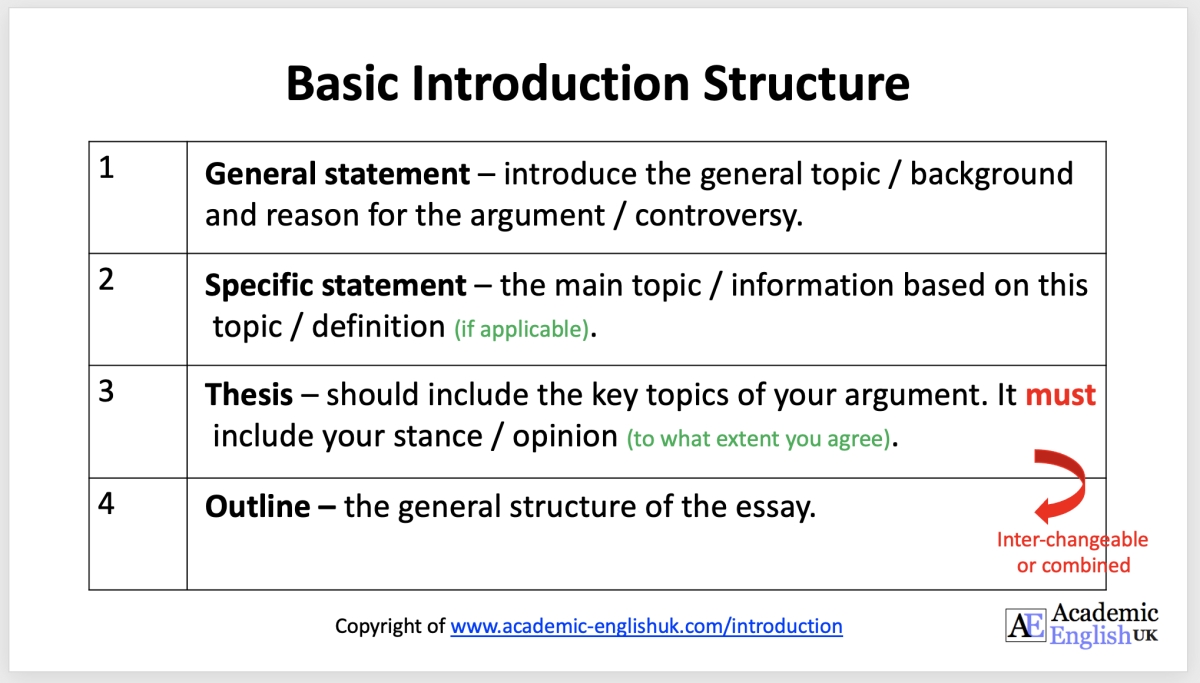
Academic Introduction example
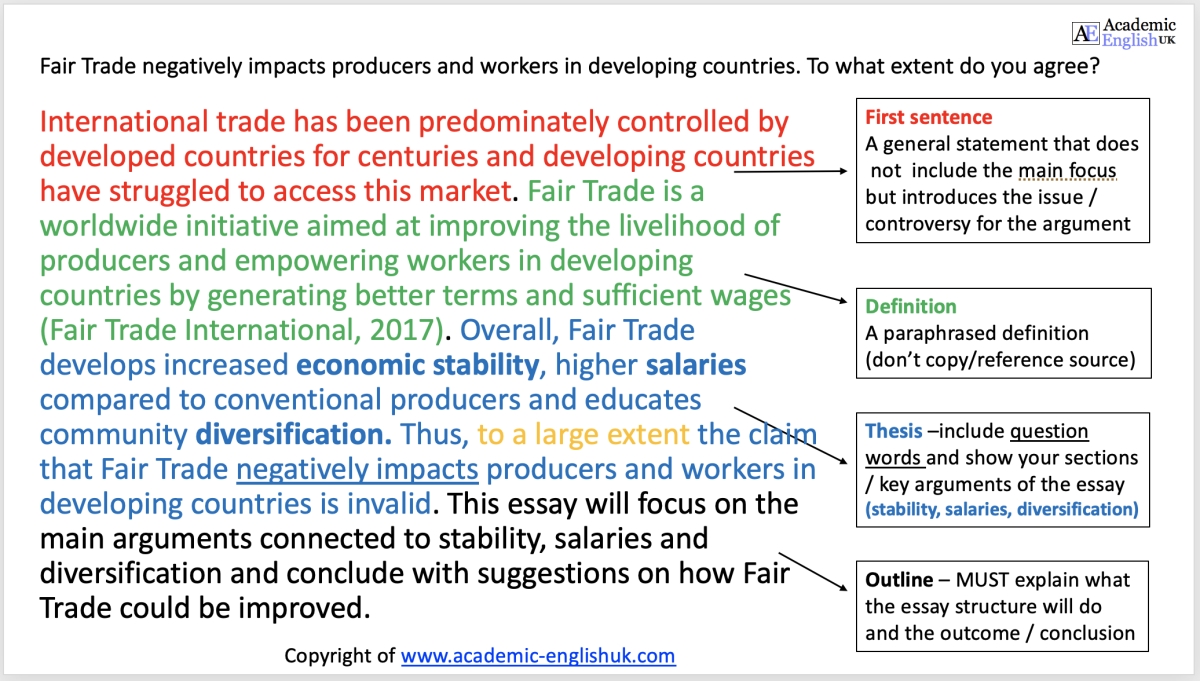
Introduction phrases
Manchester university phrase bank is a great resource to help create and structure an introduction. Key phrases include:
- Establishing the importance of the topic for the world or society
- Establishing the importance of the topic for the discipline
- Establishing the importance of the topic (time frame given)
- Establishing the importance of the topic as a problem to be addressed
- Referring to previous work to establish what is already known
- Explaining the inadequacies of previous studies
- Identifying a knowledge gap in the field of study
- Stating the focus, aim, or argument of a short paper
- Outlining the structure of the paper or dissertation
- Explaining key terms used in the current work
M ore introduction phrases : click here
Introductions: ho w to write an academic introduction.
Thesis Statements: How to write a thesis statement.
This lesson / worksheet presents the key sections to an academic introduction. It focuses on different writing structures using words like however, although, despite and then includes a writing task. Students write three thesis statements using the introduction models. Example Level: ** *** [B1/B2/C1] / Webpage link / TEACHER MEMBERSHIP / INSTITUTIONAL MEMBERSHIP
£4.00 – Add to cart Checkout Added to cart
Academic Introduction example [ the thesis statement ]
Question: fair trade negatively impacts producers and workers in developing countries. to what extent do you agree, international trade has been predominately controlled by developed countries for centuries and developing countries have struggled to access this market. fair trade is a worldwide initiative aimed at improving the livelihood of producers and empowering workers in developing countries by generating better terms and sufficient wages (fair trade international, 2017). overall, fair trade develops increased economic stability, higher salaries compared to conventional producers and educates community diversification. thus, to a large extent the claim that fair trade negatively impacts producers and workers in developing countries is invalid. this essay will focus on the main arguments connected to stability, salaries and diversification and conclude with suggestions on how fair trade could be improved., highlighted sections, international trade has been predominately controlled by developed countries for centuries and developing countries have struggled to access this market. fair trade is a worldwide initiative aimed at improving the livelihood of producers and empowering workers in developing countries by generating better terms and sufficient wages (fair trade international, 2017). overall, fair trade develops increased economic stability , higher salaries compared to conventional producers and educates community diversification. thus, to a large extent the claim that fair trade negatively impacts producers and workers in developing countries is invalid . this essay will focus on the main arguments connected to stability, salaries and diversification and conclude with suggestions on how fair trade could be improved., question: fair trade negatively impacts producers / workers / developing countries, essay topics: economic stability / salaries / diversification, stance: invalid, writing resources , academic phrases, academic style [1], academic style [2], academic style [3], academic style [4], academic word list , writing websites, error correction, hedging [1], hedging [2], nominalisation, noun phrases [1], noun phrases [2], the syllabus, referencing, in-text referencing, harvard ref. [1], harvard ref. [2], apa ref [1], apa ref [2], ref. generators, reference lists, reporting verbs, credible sources, evaluating sources, academic integrity, 'me' in writing, writer's voice , writing skills, paraphrasing [1], paraphrasing [2], paraphrase (quotes), summary writing , summary language, critical thinking, analysis & evaluation, fact vs opinion, argument essays, spse essays, sentence str. [1], sentence str. [2], sentence str. [3], punctuation, academic posters, structure , essay structure, introductions, thesis statements, paragraphing, paragraphs: quotes, topic sentences [1], topic sentences [2], definitions, exemplification , conclusions, linking words, parallelism, marking criteria, terms & conditions of use.
Memberships (Teacher / Institutional)
Full access to everything - £100 / £200 / £550
Join today * x
More Blog Articles…

Advertisement

Academic Essay
Essay generator.
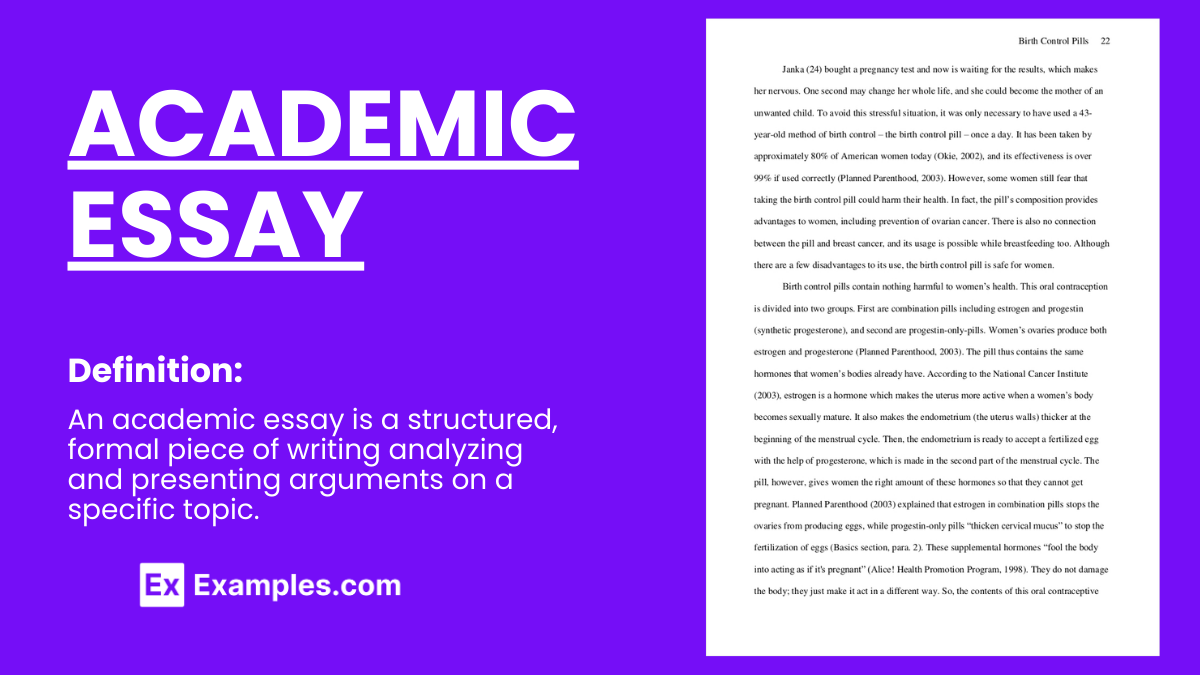
When creating an academic essay , it is very important for you to relay a sensible and clear argument to your target readers. Since academic essays are widely used in the field of education and research, you need to ensure that you do both logical, interesting and informative writing . The items that are commonly seen in an academic essay contain insights, actual occurrences, ideas, and facts.
What is Academic Essay?
An academic essay is a structured form of writing that serves the purpose of presenting and supporting a thesis or argument on a specific topic. It is commonly used in educational settings to assess students’ understanding, analytical skills, and ability to research and convey their findings. An academic essay typically follows a clear format, including an introduction with a thesis statement, body paragraphs that provide evidence and analysis to support the thesis, and a conclusion that summarizes the main points and reinforces the essay’s central argument. This type of essay requires critical thinking and a formal tone, with evidence cited from reputable sources to back up claims made within the text.
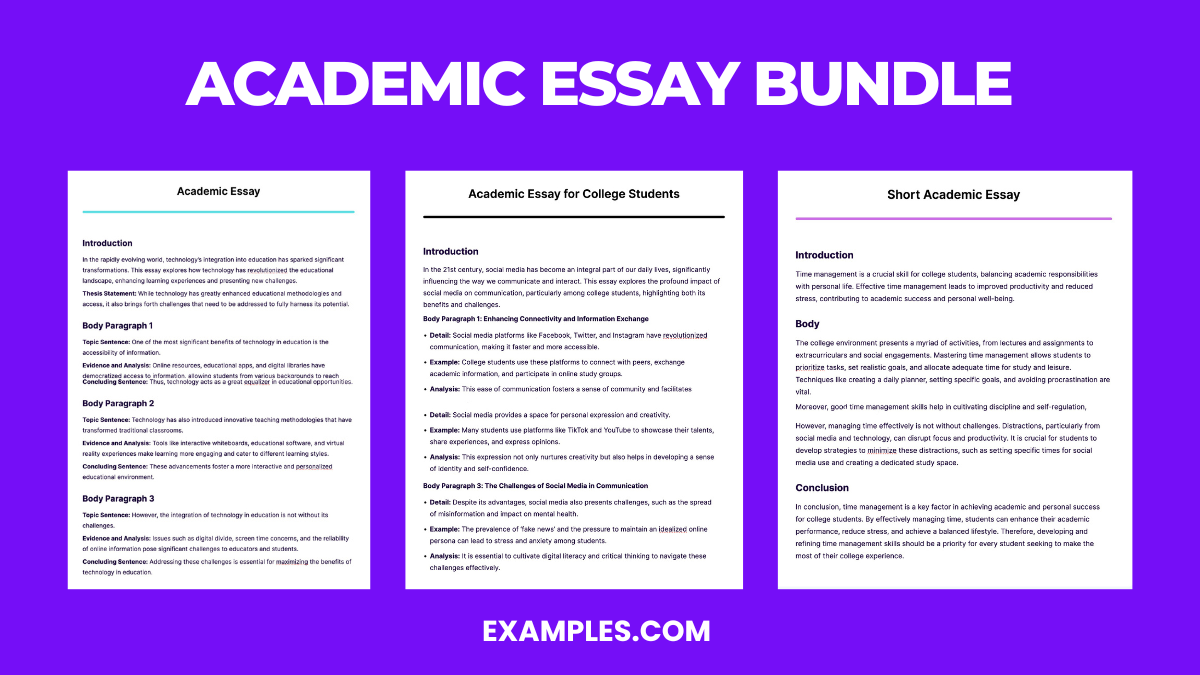
Download Academic Essay Bundle
A lot of students tend to think that an academic essay, just like any other college essay , is something that is too technical or defined. However, you can always write one depending on how you perceive a specific topic of discussion or how you interpret an instance or any other subjects. The samples that we have for you can be a great help if you would like to start writing your academic essay already.
Academic Essay Writing Format/ Outline
1. title page (if required).
Includes the essay’s title, the author’s name, and institutional affiliation.
2. Introduction
Hook : Opens with a statement to grab the reader’s interest. Background Information : Provides context for the topic being discussed. Thesis Statement : Presents the main argument or claim of the essay.
3. Body Paragraphs
Each paragraph should focus on a single idea that supports the thesis, structured as follows:
Topic Sentence : Introduces the main idea of the paragraph. Evidence and Analysis : Includes data, quotes, or examples to support the topic sentence, followed by an explanation of how this evidence supports the thesis. Transition : Connects to the next paragraph or idea.
4. Conclusion
Summary of Main Points : Restates the key arguments or findings presented in the body paragraphs. Restatement of Thesis : Reinforces the essay’s main argument in light of the evidence presented. Closing Thought : Offers a final insight, a call to action, or a suggestion for further research.
Example of Academic Essay Writing
The Impact of Social Media on Communication In the digital age, social media has revolutionized the way we communicate, transcending physical boundaries and transforming social interactions. This essay explores the profound impact of social media on communication, examining both its positive advancements and negative implications. While social media platforms like Facebook, Twitter, and Instagram have enhanced our ability to connect with others, they have also led to a decline in face-to-face interactions and a dilution of personal communication skills. Social media has made it easier than ever to stay connected with friends and family, regardless of geographical distance. A study by Smith and Duggan (2016) found that 75% of internet users utilize social media to maintain relationships with distant family and friends. This widespread use of social media for keeping in touch demonstrates its role as a vital communication tool, bridging the gap between people worldwide. However, the reliance on social media for communication has led to a decrease in the quality of interpersonal interactions. Research by Johnson (2018) indicates a 40% decline in face-to-face conversations among young adults, correlating with increased social media usage. The preference for digital communication over personal interaction suggests a shift in social dynamics, potentially harming relational depth and emotional connections. Moreover, social media has affected our communication skills, particularly among younger generations. A survey by Lee (2019) revealed that 60% of teachers believe social media use has adversely affected students’ writing and verbal communication skills. The informal language and abbreviations common in social media posts and messages are infiltrating academic and professional communications, underscoring the need for a balanced approach to digital interactions. Social media has undeniably transformed communication, offering unparalleled connectivity but also presenting significant challenges. While it fosters global connections, its overuse can undermine personal interactions and communication skills. Balancing social media use with face-to-face communication is crucial for maintaining meaningful relationships and effective communication in the 21st century.
What is an example of academic writing?
Title: The Impact of Climate Change on Biodiversity
Introduction: Climate change, driven primarily by human activities such as the burning of fossil fuels and deforestation, has emerged as a critical global concern. This essay aims to explore the multifaceted impacts of climate change on biodiversity. The effects of rising temperatures, altered weather patterns, and habitat destruction are increasingly evident, with far-reaching consequences for ecosystems and species worldwide.
Body Paragraph: One of the most noticeable consequences of climate change is the shifting geographical ranges of numerous species. Warmer temperatures prompt species to migrate to higher altitudes or latitudes, as they seek habitats that align with their thermal preferences. This phenomenon is evident in various ecosystems, including mountain regions, where alpine plants and animals have progressively moved uphill. These migrations, while adaptive, can disrupt established predator-prey relationships and competition for resources. Such shifts can also lead to reduced biodiversity in lower-altitude regions as some species fail to adapt or relocate successfully.
- Smith, J., & Johnson, A. (2019). Impacts of Climate Change on Alpine Plant Communities. Environmental Studies Journal , 42(3), 256-270.
- Wilson, P., & Davis, R. (2020). Climate-Induced Shifts in Animal Distributions: Evidence from a Decadal Study. Ecology and Evolution , 10(12), 5963-5972.
Conclusion:
In conclusion, climate change exerts profound effects on biodiversity, manifesting through shifts in species distributions, altered ecological relationships, and habitat loss. As global temperatures continue to rise, addressing these impacts becomes increasingly urgent. Conservation efforts, sustainable practices, and international cooperation are essential in mitigating the repercussions of climate change on the world’s diverse ecosystems and species.
Academic Essay Topics with Samples to Edit & Download
- Pollution due to urbanization
- The environmental causes of smoking
- The outcomes of global warming
- Abortion as a controversy
- Causes of obesity in teenagers
- Childhood memories
- Fathers should get equal paternity leave
- Harmful dogs should be euthanized
- How does divorce affects children?
- How does technology affect productivity?
- Importance of preserving threatened species
- Parenting styles and motives
- Political issues in the U.S.
- Romantic relationships
- Should schools abolish homework?
- Violent video games should be banned
- Ways of protecting the environment
Academic Essay Writing Examples & Templates
1. academic essay example.
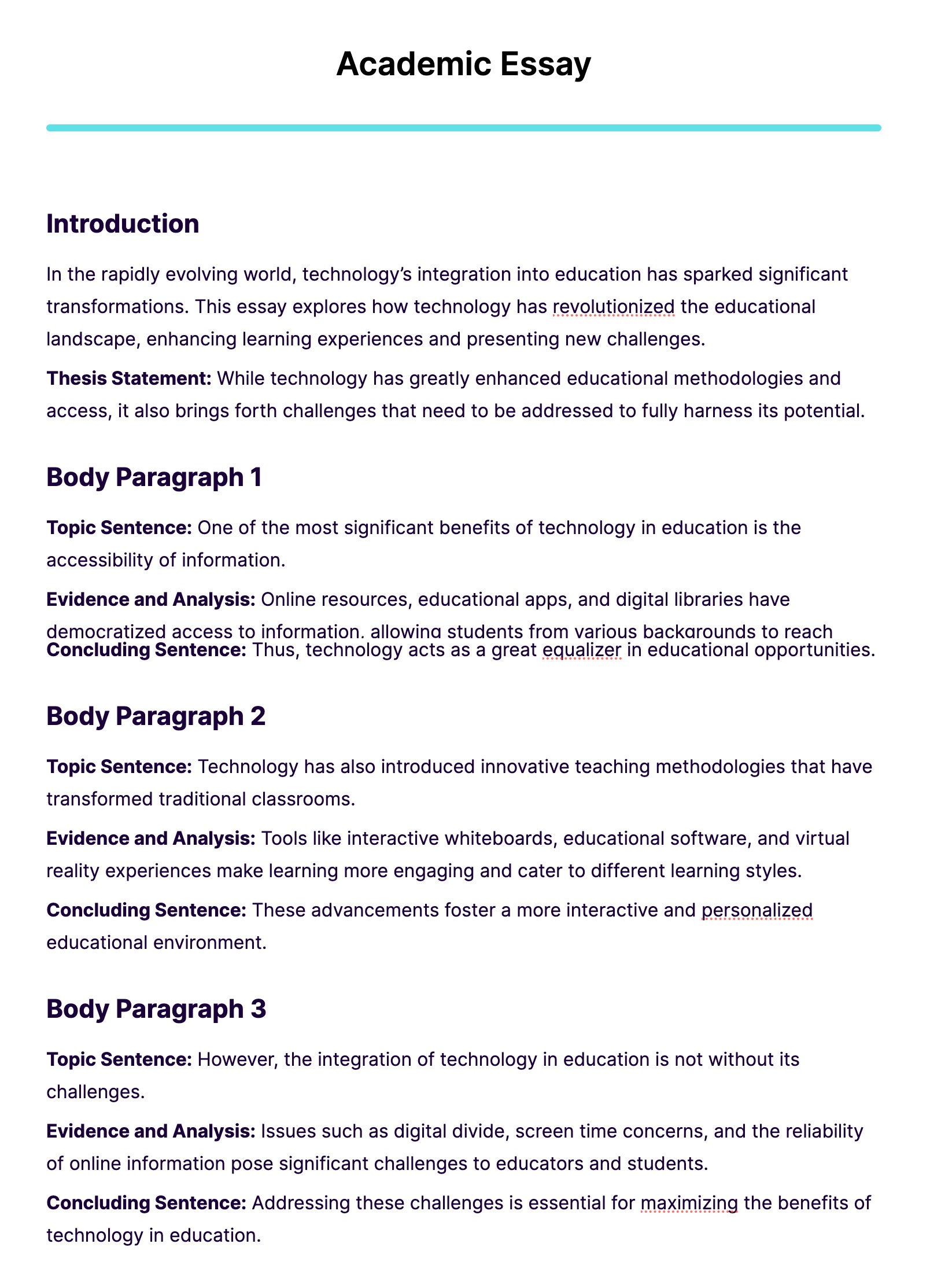
Free Download in PDF
2. Academic Essay for College Students
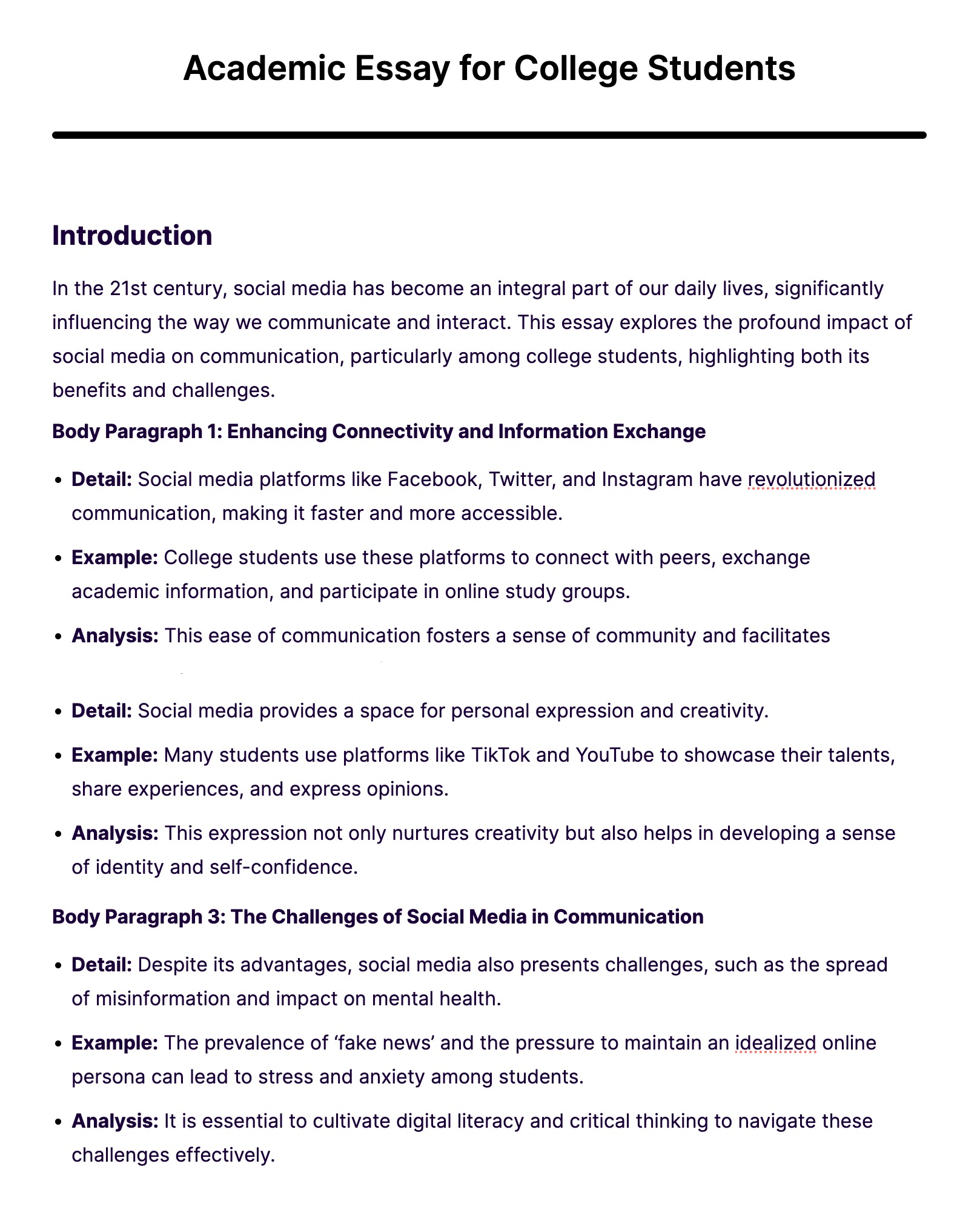
Edit & Download
3. Short Academic Essay
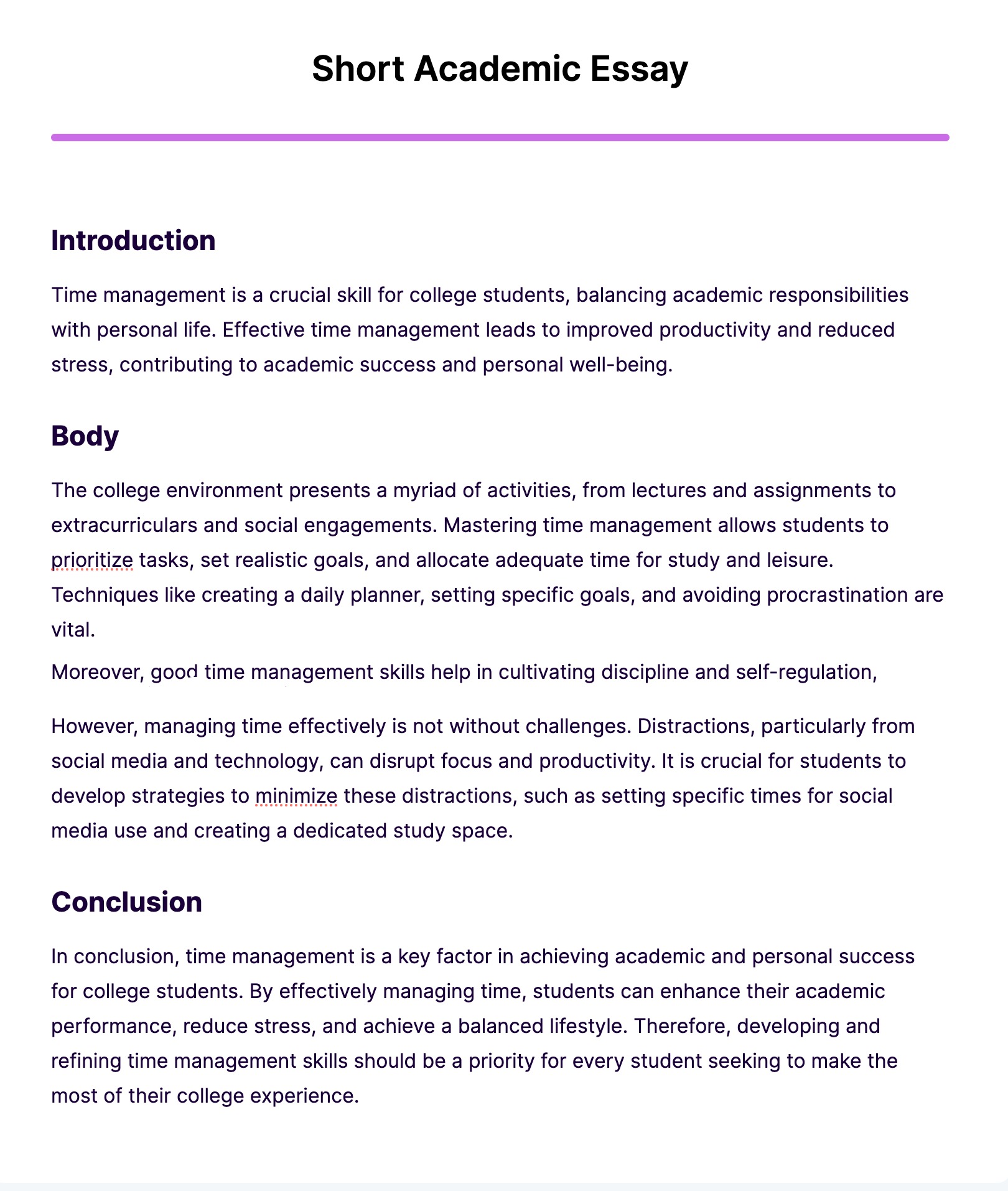
4. Academic Essay Template
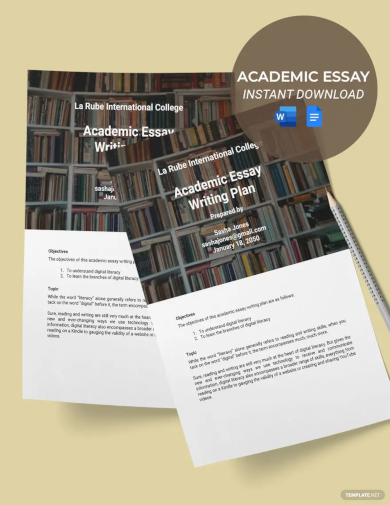
5. Academic Writing Essay Template
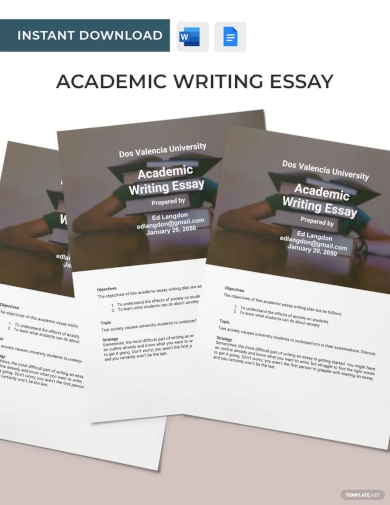
6. Academic Text Example Essay Template
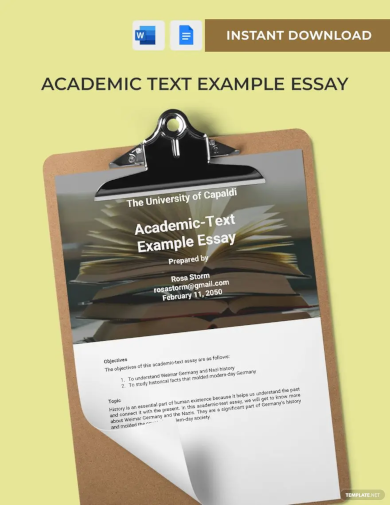
7. Academic Essay Writing Examples
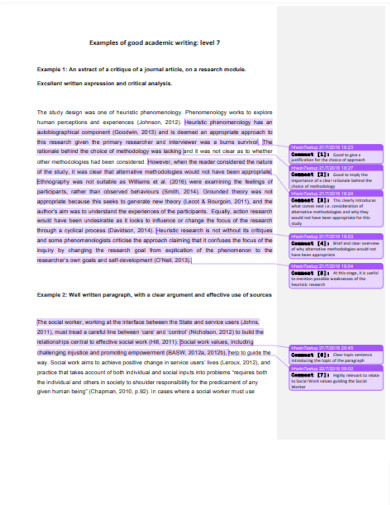
academic-skills.health.herts.ac.uk
8. Academic Essay for College Students Examples

9. Narrative Academic Essay Examples
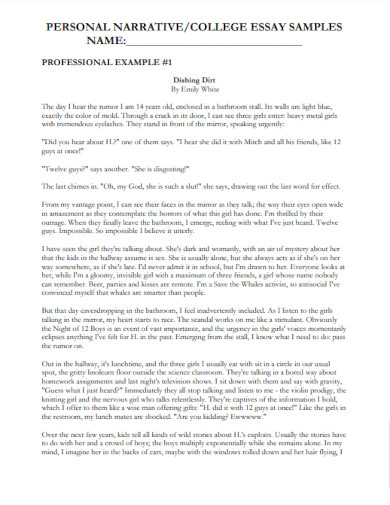
learning.hccs.edu
10. Sample Academic Essay Format Example

owll.massey.ac.nz
11. Academic Paper Essay Example
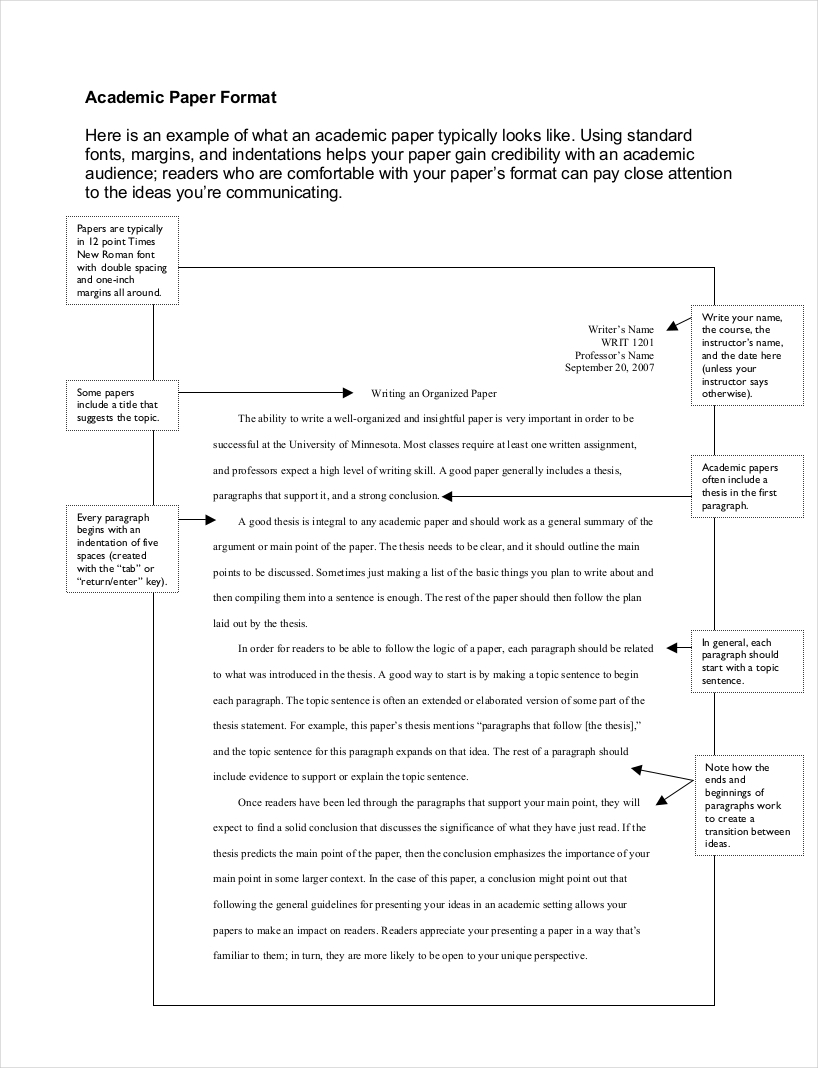
writing.umn.edu
12. Simple Academic Essay Example
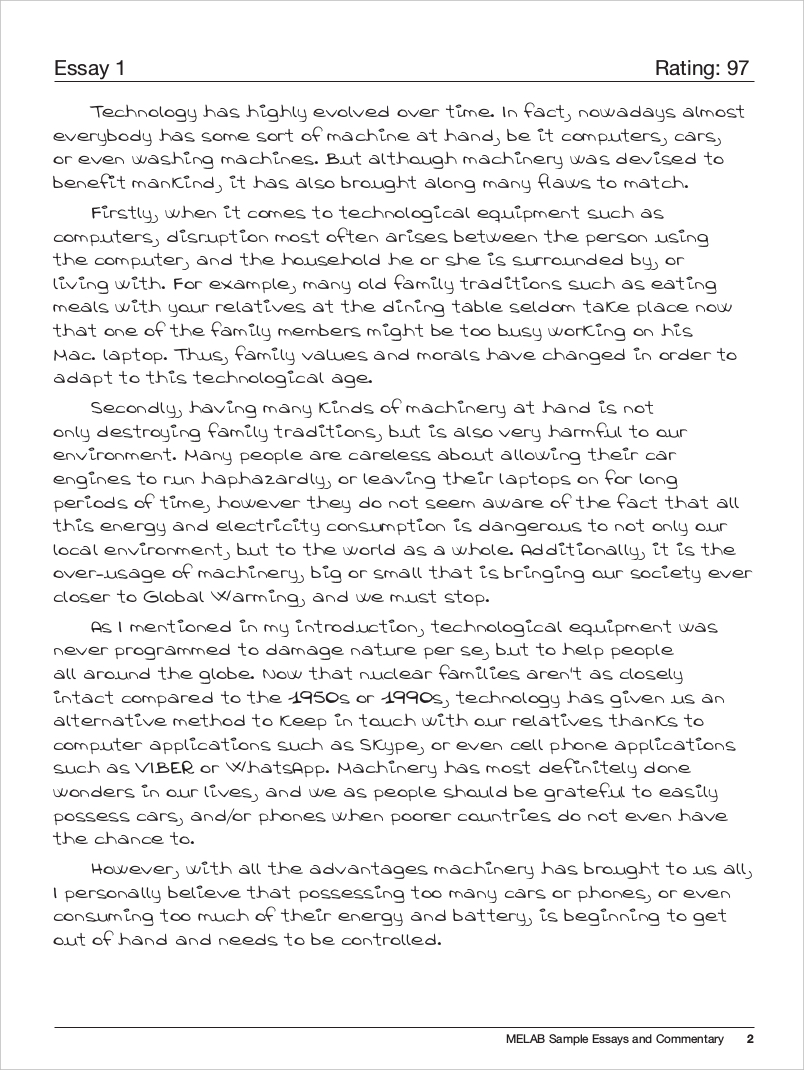
cambridgemichigan.org
13. Academic Essay Sample Structure Example
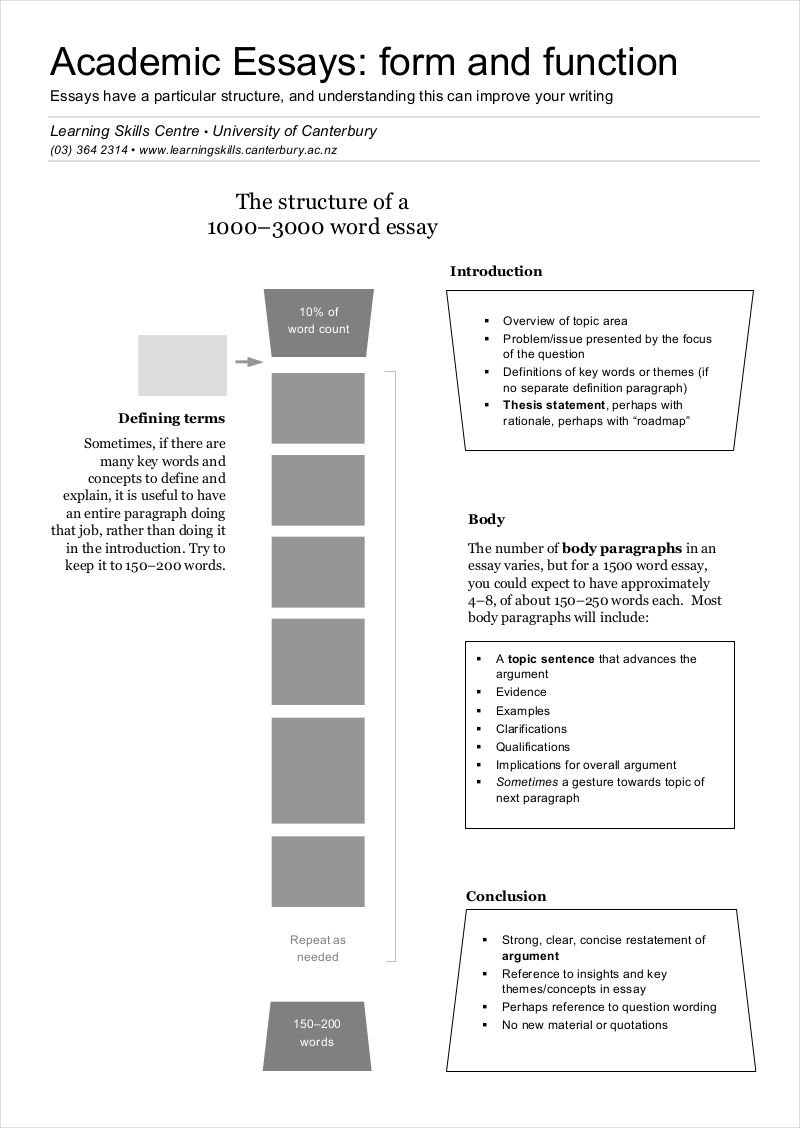
lps.canterbury.ac.nz
14. Short Academic Essay Example in PDF
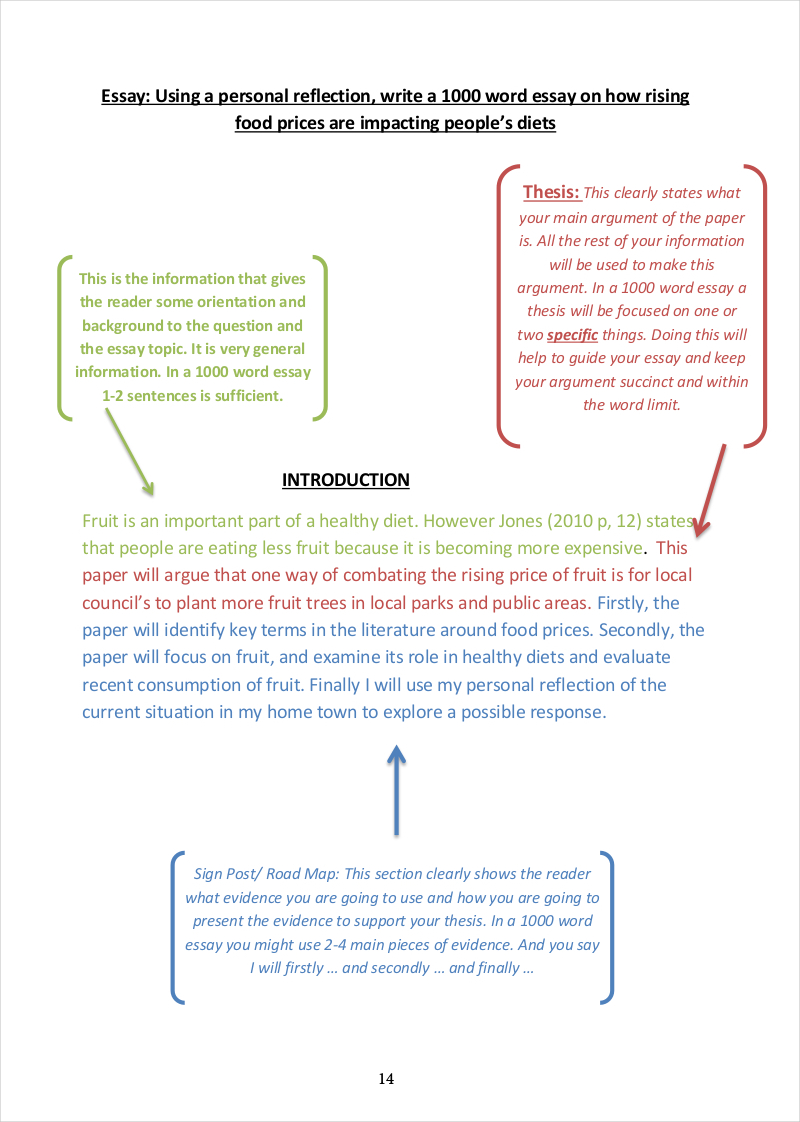
15. Free Printable Academic Essay Sample
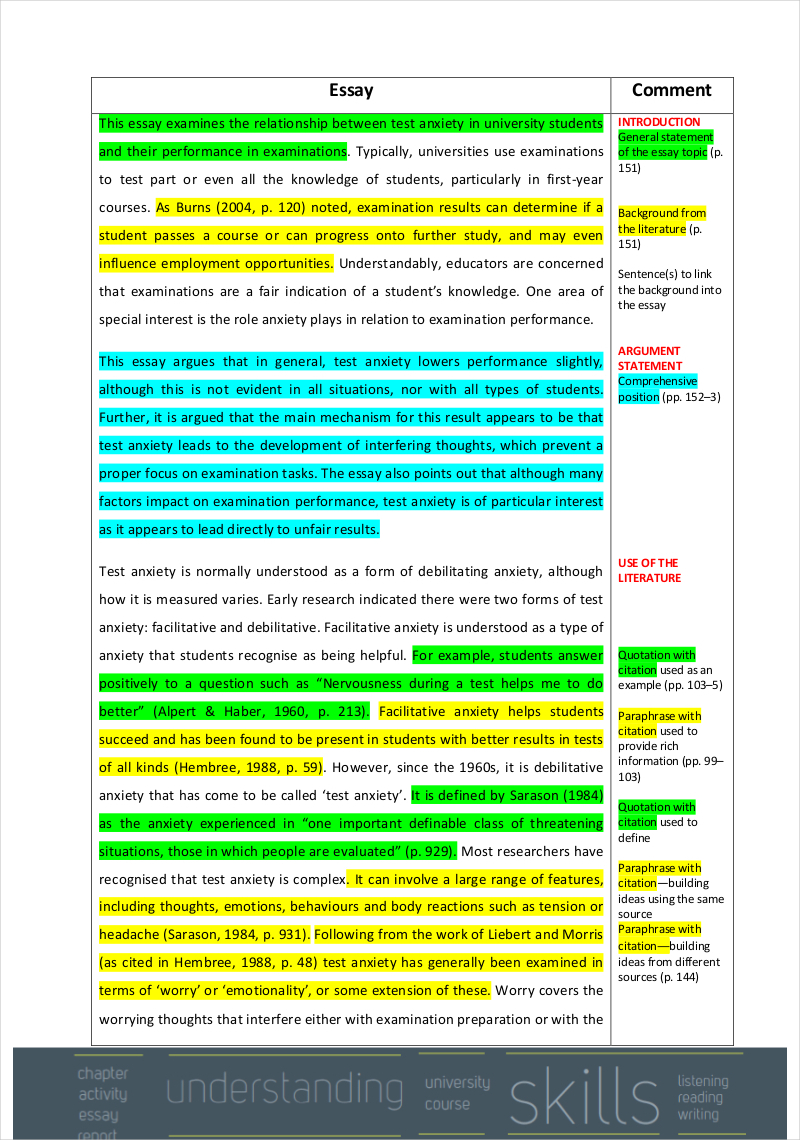
lib.oup.com.au
16. Sample Academic Essay Example
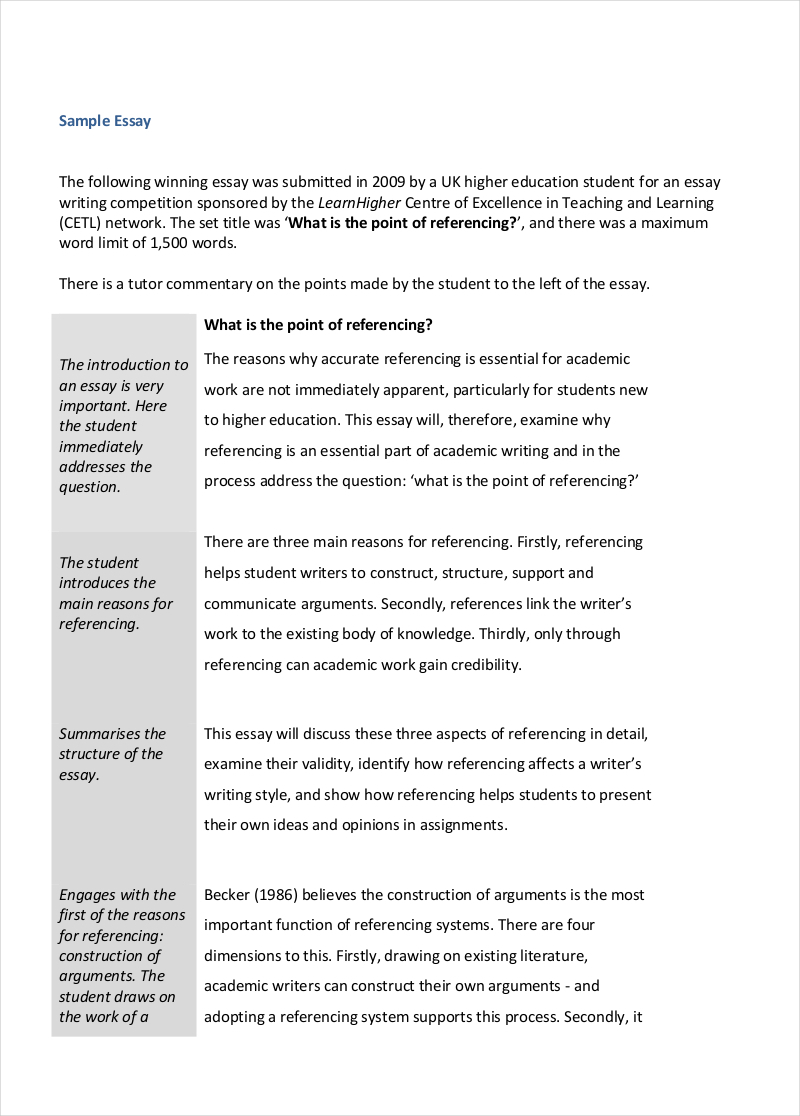
17. Academic Essay Writing Sample Example
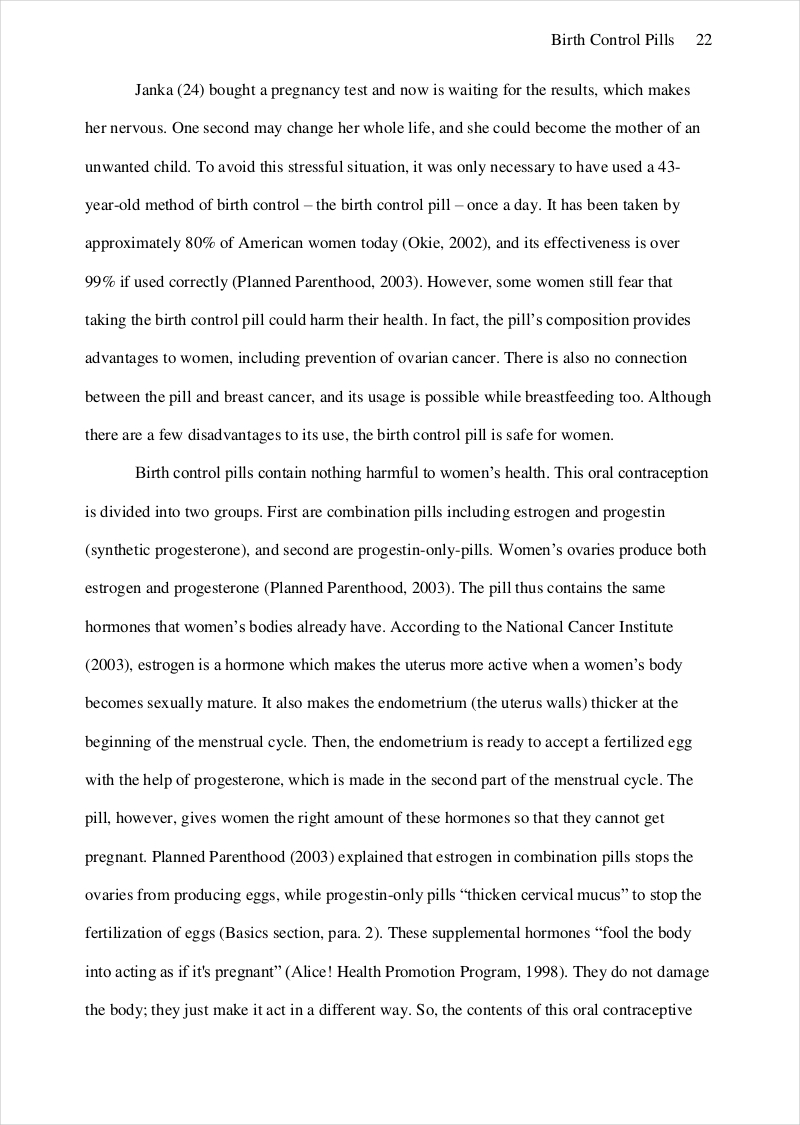
18. Free Academic Essay Sample Guide

intranet.ecu.edu.au
19. Sample Academic Essay Outline
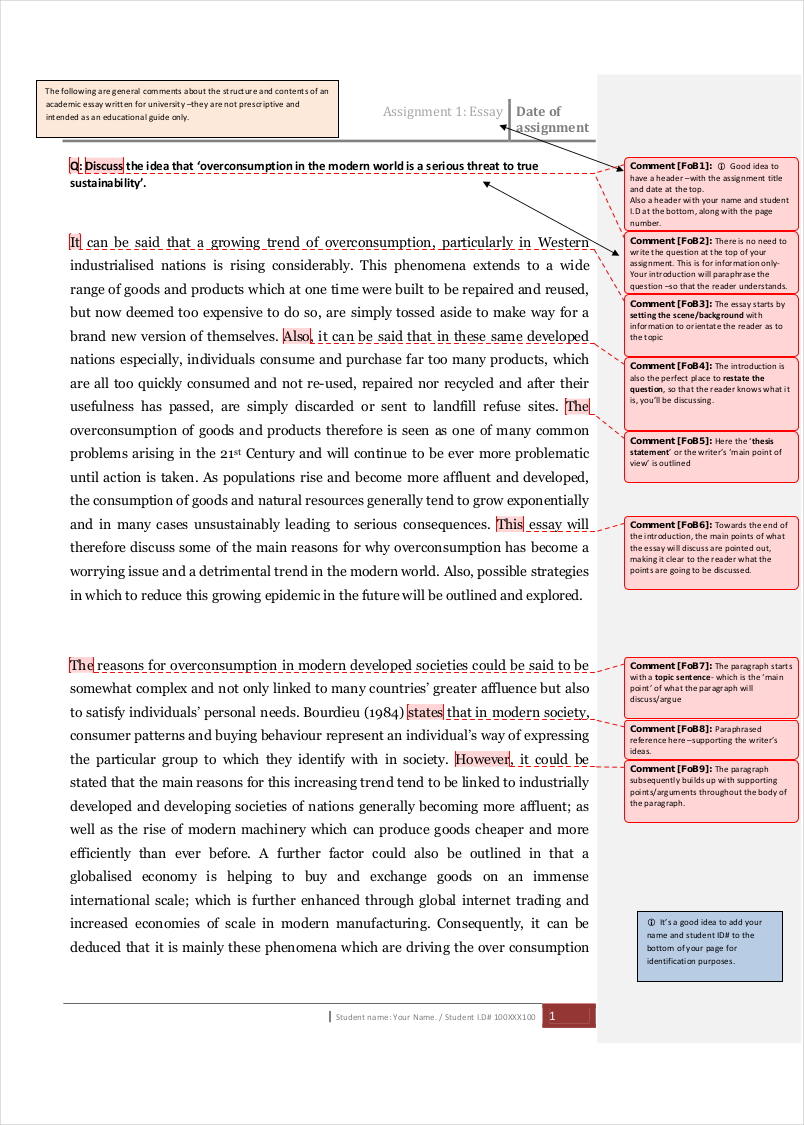
lib.uts.edu.au
Are You Ready and Prepared to Create an Academic Essay?
Different types of academic writing require an individual to have a clear thought process within the entirety of idea development. You have to be focused on what you would like to achieve your final written output so you can incorporate successful guides and processes within the activity. Some of the things that you can talk about in an academic essay include the following:
- Human behavior, characteristics, and emotions
- Community relations
- Natural occurrences
- Language and its effective usages
- Culture and the arts
- Academic researchers
- Relevant cultural phenomenon
- Photography and other artistic undertakings
- Human interactions
- Other subjects that are related to education and academics
Knowing the subject of your article is only one of the initial things that can help you prepare during the writing process. Here are some ways on how you can be ready to write your academic essay:
- You need to have an order of writing that can easily showcase the flow of your thoughts. You must ensure that you can easily connect with your readers or audience so they can respond to the content of your article. Your academic essay should evoke an emotion that is necessary to spark other ideas, opinions and other kinds of responses.
- You need to be aware that academic essays differ depending on the educational or academic discipline where they will be used. There are certain ways that are necessary to be followed in various fields for an academic essay to be deemed effective. With this, always be mindful of the directions or instructions were given to you by the entity who requires you to write an academic essay.
- You do not need to pattern your writing to the works of others. You can be ready even by just knowing your subject and researching about it. The style of writing that you have can give the most difference to how you write and how you present your work. Always keep in mind that your academic essay should be playful – it must not bore your audience.
- You must think of your academic essay as an enterprise by using scholastic writing approaches. The conversation that you can create with your readers must be relevant to what is happening nowadays or for the study that specific student groups need. Being able to give focus on the relativity of your written work can make it easier for readers to understand why your academic essay is important within the academic field.
- You should ensure that your thesis statement is precise, concise, and strong. When you are in the process of developing your academic essay’s thesis, you need to make sure that you are not just basing your write-up on unreliable information. Always refer to evidence, facts, and real data as it can help you strengthen your claims. More so, do not forget to reference your essays when necessary.
Things to Remember When Identifying the Purpose of Your Academic Essay
An academic essay always has to be relevant. It needs to be beneficial to a specific group or to the majority of the academic community. The motive of your essay is very important to be considered as it can identify whether you can be of help to the people who need a particular educational reference. Here are a few things that you need to remember when identifying the purpose of your own academic essay:
- Do not create an academic essay just for the sake of passing it. Your academic essay is more than an assignment or a project. There are some last minute essay writing activities that are done in various fields especially if students think that an academic essay is just a part of their requirements. However, what these students do not know is that an academic essay is a representation of themselves. It showcases the thoughts of the students, what they have learned may it be in class or through self-discovery, and how they are impacted by certain issues and subjects of discussion. This is where the value of a Free Essay and an Informative Essay becomes evident, as both types of essays encourage students to express their understanding and insights on a given topic freely and informatively.
- Be precise with the purpose of your writing. An academic letter is not just a document that can showcase your mastery when it comes to a particular academic subject. It can talk about a specific subject or it can also be a general paper that can provide a lot of information about your experiences and/or insights. This is where the importance of a Self-Introduction Essay comes into play, allowing you to present a personal narrative that reflects your academic journey and achievements. Similarly, an Expository Essay helps in laying out facts and an unbiased analysis of a topic, further enriching the academic discourse. If you will have a precise purpose when writing an academic essay, there is no doubt that your essay will not be pointless.
- Always think of the best case that can help you represent your thoughts. Your style of writing, as well as the entire document’s format and content, can help you realize your ideas. This includes the succinctness and clarity often found in a Short Essay , where the challenge is to convey your thoughts within a limited word count effectively. Similarly, a Scholarship Essay requires you to articulate your achievements and aspirations in a way that resonates with scholarship committees, demonstrating your potential and need for financial support. With this, your point of writing can easily be identified by readers. Being able to present your purpose the best way possible can add up to the success of your academic paper.
Developing an Academic Essay
For you to be able to persuade your readers with the content of your academic essay, there is a need for you to present a structure that can easily identify your claims, arguments, observations, and/or factual presentations. Integrating a Student Essay can demonstrate the personal perspective or learning journey of an individual, making your arguments more relatable. Similarly, incorporating a Travel Essay could enrich your essay by providing unique insights and observations from different cultures or environments. Being clear about how you present your idea is essential for people to see the context of your academic essay.
If you have an organized manner of putting together the concepts of your academic essay, then validating your thesis statement can be more evident. To avoid common essay mistakes and other negative factors that can affect your desired output, here is a basic guide on how you can develop your own academic essay:
- Start by creating a strong thesis statement. Identify your stand and make sure to strictly present evidence that can help you claim its authenticity and validity. Reveal evidence after your thesis statement presentation. Your thesis statement serves as your introduction speech . It lets your readers know the topic of your academic essay and what they can expect from the entire article.
- Establish the context of your essay after your thesis statement. The way that you approach your topic can let readers know whether it is the specific approach that they also need for their undertakings. There are different contexts that can be used within the same subject, so you have to make sure that you will be clear when it comes to identifying the part of the topic that you are going to talk about. This clarity can be achieved through a Descriptive Essay , where vivid descriptions and details about the topic can enlighten and engage the reader. Additionally, understanding the Parts of an Essay is crucial in structuring your thoughts and arguments effectively. Limiting your topic discussion can help you give more focus to what is important for your discussion, ensuring that each part contributes meaningfully to the whole.
- Create the next paragraphs based on the data that can support your thesis statement. The body of your academic essay can be based on your observations, reviews, statements and research outputs. You can present these items separately through the usage of various paragraphs. However, there are instances where it will be better if you can combine or compare to evidence to make your statements more effective.
- Conclude. Your conclusion is as important as your introduction. If you believe that you have created a strong introduction, you have to maintain that until the end of your academic essay. Sum up all the information that you have presented so that people can identify whether your conclusion has lived up to the content of what you have written. Your conclusion can also be used to assess whether your thesis statement has been carried within the entirety of your discussion.
Importance of a Well-Defined Thesis Statement in an Academic Essay
A thesis statement is a paragraph or a set of paragraphs that identifies your stand about your subject. There is a need for this statement to be created as it can affect the entirety of your academic paper. Here are some of the reasons why it is important to develop an effective thesis statement before and while writing your academic paper:
- Your thesis statement is a reflection of your actual idea. This helps you present the point that you would like to make and the message that you actually want to disseminate to your readers. Through a thesis statement, you can organize the evidence that are relevant to your claims based on their relevance to the topic and how you view it as a writer.
- Your thesis statement can guide you within the entirety of your writing processes. Just because you have already done an initial thesis statement does not mean that you are going to fully stick with it until the end of your writing. There are instances where thesis statements are developed or even changes during the creation of an academic essay depending on how the research about the topic has evolved.
- Your thesis statement can allow you to establish originality. Since your academic essay can be based on your research findings and observations, your thesis statement can be your platform to specify what you have come up with. Through a well-defined thesis statement, you can set your output apart from other essay examples that have been written by professionals and other entities in the field of academics.
- Your thesis statement is one of the items that the audience will look at when referencing for credibility and validity. Academic essays need to have a strong initial impact on readers. This statement can help them be focused on a particular standpoint which can enlighten them about your views and opinions, and how these are essential to be considered.
- Your thesis statement can help your readers immerse in your academic essay. The material that you will be coming up with can be reviewed by different people. Depending on the field of education where you are currently in, you need to make sure that your readers can see patterns of evidence presented so they can clearly see how you were able to generate and come up with insights. You have to ensure that the thesis statement that you have created contains the most promising thought so you can get the trust or even the acceptance of your readers about your academic essay’s subject.
Guidelines in Writing an Academic Essay
The course materials that you need to talk about within an academic essay can reflect your level of understanding about the subject. Simply put, an academic essay can be an evidence of the depth of your research procedures and all the other activities that you have executed so that you can support the content of your written output. Listed below are some of the guidelines that can be useful to your academic essay writing processes.
- Always analyze your essay prompt or the question that you need to answer or explain. You have to know whether you are tasked to argue, analyze, or discuss the topic. There will be times where you also need to compare the items present in your subject or explain the underlying factors that can affect your topic.
- Make sure that you will research about what you will write about . Your academic essay can only be fully-maximized if you can present facts. Primary research may be a helpful bit a more precise review of your research topic can help you gather more information that can be helpful in the development of your content. Always assess your sources of information so you can ensure that they are credible.
- Create a draft so that you will have a guide when writing your academic essay. If you will be organized when writing your academic essay, you can create an output that is well-curated and comprehensive. With this, your academic essay can provide more impact to your readers. This can also help you gather your thoughts first and identify how you can put them all together in the most cohesive and efficient way possible.
If you still do not feel confident in writing your own academic essay from scratch, then you can refer to templates and samples which you can download online. Doing this will allow you to be more familiar with the common content and basic formats that are usually seen in an academic essay. When using a template as a guide, always make sure that it is applicable to the study that you are practicing or the academic field or discipline where you will use your academic essay.
As a student, there will always be an instance where we will be required to write an academic essay. If you want to create an academic essay that is both outstanding and relevant, always put the items that we have discussed above in mind.
Setting the Stage for Essay Writing Success
- Understand the Assignment: Carefully read and comprehend the essay prompt or assignment to grasp its requirements and objectives.
- Topic Selection: Choose a relevant and interesting topic that aligns with the assignment.
- Research: Gather credible sources and information related to your topic. Take thorough notes and document your sources.
- Thesis Statement: Develop a strong, clear, and concise thesis statement that presents the main argument of your essay.
- Outline: Create an outline that organizes your essay into sections, including the introduction, body paragraphs, and conclusion. Each section should have a clear purpose.
- Writing Draft: Begin writing your essay, keeping the introduction engaging, and ensuring each body paragraph addresses a single point or idea supported by evidence.
- Citations: Properly cite sources as you write, following a recognized citation style (e.g., APA, MLA).
- Edit and Revise: Review and revise your draft, focusing on grammar, clarity, coherence, and organization.
- Proofread: Carefully proofread your essay for errors in spelling, punctuation, and sentence structure.
- Final Review: Double-check that your essay fulfills the assignment requirements, including formatting, citations, and references.
How do you write an academic essay?
- Understand the Assignment: Read the essay prompt or assignment thoroughly to grasp its requirements and objectives.
- Research: Gather relevant sources and information from books, articles, and credible online sources.
- Plan and Outline: Create an outline with an introduction, body paragraphs, and a conclusion. Each section should have a clear purpose.
- Thesis Statement: Develop a strong thesis statement that presents the main argument of your essay.
- Introduction: Start with a compelling hook, provide background information, and present your thesis statement.
- Body Paragraphs: Each paragraph should focus on a single point or idea, supported by evidence or examples. Use topic sentences to introduce the main idea of each paragraph.
- Citations: Cite sources properly using a recognized citation style (e.g., APA, MLA, Chicago).
- Analysis and Critical Thinking: Analyze and evaluate the evidence or arguments presented, and make connections between them.
- Transition Sentences: Use transition words and phrases to connect ideas between paragraphs.
- Conclusion: Summarize the main points, restate the thesis, and provide a thoughtful conclusion that leaves a lasting impression.
Academic Essay Characteristics
Academic essays are distinguished by several key characteristics that set them apart from other types of writing. These features ensure that essays meet the rigorous standards of academic discourse and contribute effectively to scholarly conversations. Here are the primary characteristics of academic essays:
- Clear Purpose : An academic essay is written with a clear purpose, often to argue a point, present an analysis, or discuss a research finding. The purpose guides the structure and content of the essay.
- Structured Format : It follows a structured format with an introduction, body paragraphs, and a conclusion. This organization helps present arguments and evidence in a coherent and logical manner.
- Thesis Statement : A distinctive feature is the thesis statement, a concise summary of the main argument or claim, usually found at the end of the introduction. It sets the direction for the entire essay.
- Critical Analysis : Academic essays involve critical analysis of ideas, texts, or situations. Writers assess evidence, debate viewpoints, and use logic to develop their arguments.
- Evidence-Based Arguments : Claims made in academic essays are supported by evidence from credible sources. This includes data, statistics, research findings, and quotations from experts.
- Formal Tone and Style : The writing adopts a formal tone and style, avoiding colloquial language, personal anecdotes (unless relevant), and slang. It maintains an objective and professional voice.
Types of Academic Writing
Academic writing encompasses a variety of types, each serving a specific purpose and adhering to a particular format. Here are some of the main types of academic writing:
- Descriptive Writing : This type focuses on describing a character, event, or situation in detail. It’s often used in reports or descriptive essays, where the goal is to provide a clear picture of the subject to the reader.
- Analytical Writing : Analytical writing breaks down complex information into smaller components for better understanding. It involves comparing and contrasting, classifying, and analyzing causes and effects. This type is common in research papers and literature reviews.
- Persuasive Writing : Persuasive writing aims to convince the reader of the writer’s viewpoint or argument. It is characterized by a strong thesis statement, clear evidence, and logical reasoning to persuade the reader. Opinion pieces, argumentative essays, and proposals often employ persuasive writing.
- Expository Writing : Expository writing is used to explain or inform the reader about a specific topic in a clear, concise, and logical manner. It focuses on presenting facts, statistics, and examples without the writer’s personal opinions. This type includes most essays, many types of reports, and certain types of research papers.
- Reflective Writing : This type involves the writer reflecting on their personal experiences, thoughts, or feelings regarding a particular subject or experience. Reflective writing is subjective and is often used in journals, blogs, and reflection essays in educational settings.
- Critical Writing : Critical writing evaluates and critiques the work of others, such as books, articles, or artworks. It involves assessing the strengths and weaknesses of arguments, evidence, and methodologies. Literature reviews, critique essays, and certain types of research papers often require critical writing.
- Narrative Writing : Although less common in strict academic settings, narrative writing is used in certain disciplines to tell stories or describe events chronologically. Personal statements and some types of qualitative research may employ narrative writing to convey experiences and observations.
- Report Writing : Reports convey information from a writer to a reader, focusing on facts and evidence. They are structured and include sections like an introduction, methodology, findings, and conclusions. Lab reports, business reports, and technical reports are examples of this type.
Academic Writing Principles
Academic writing is governed by a set of core principles designed to ensure clarity, precision, and rigor in scholarly communication. Understanding and adhering to these principles is essential for effective academic writing. Here are the key principles:
- Clarity : Writing should be clear and understandable, avoiding unnecessary jargon and complexity to ensure that the reader can easily follow the argument or narrative.
- Coherence : The text should be logically organized, with a clear structure that guides the reader through the argument or discussion. Each part of the writing should connect to the others in a meaningful way.
- Conciseness : Academic writing should be concise, conveying ideas in as few words as necessary. This does not mean oversimplifying, but rather avoiding redundancy and verbosity.
- Objectivity : Writers should strive for objectivity, presenting information and arguments based on evidence rather than personal opinions or biases. This includes acknowledging counterarguments and limitations.
- Precision : Precision involves using the exact words to convey your meaning and being specific about your claims, evidence, and references. This also means accurately citing sources and providing specific data when necessary.
- Evidence-Based Argumentation : Arguments should be supported with appropriate evidence, such as data, examples, and citations from authoritative sources. This principle underscores the importance of research and verification in academic writing.
- Formality : The tone of academic writing is formal, which means avoiding colloquial language, contractions, slang, and humor. Formality also involves using the passive voice where appropriate and avoiding personal pronouns when making general arguments.
- Citation and Referencing : Proper citation and referencing of sources are fundamental to academic writing. This practice not only gives credit to original authors but also allows readers to verify sources and understand the basis of the evidence presented.
- Originality and Plagiarism Avoidance : Academic writing must be original and free from plagiarism. This means that writers should produce their own work based on their research and ideas and appropriately cite any sources they use.
- Critical Thinking : Effective academic writing reflects critical thinking, challenging assumptions, evaluating evidence, and synthesizing ideas from various sources to offer new insights or perspectives on a topic.
How do you start an academic essay sample?
Begin an academic essay sample with a captivating hook, provide context on the topic, and conclude the introduction with a clear and concise thesis statement that outlines your main argument.
What is the opening line of an academic essay?
The opening line of an academic essay should engage the reader’s interest, introduce the topic, and provide a sense of the essay’s focus and importance.
What not to write in an academic essay?
In an academic essay, avoid personal opinions, emotional language, unsubstantiated claims, informal language, and plagiarism. Focus on evidence-based arguments and adhere to academic standards and conventions.
How do you write an academic essay quickly?
To write an academic essay quickly, start with a clear thesis, outline main points, research efficiently, focus on key evidence, and minimize editing while maintaining proper citations and structure.
Text prompt
- Instructive
- Professional
Write an academic essay on the impact of technology in education
Explain in an academic essay how climate change affects global agriculture

IMAGES
VIDEO
COMMENTS
Table of contents. Step 1: Hook your reader. Step 2: Give background information. Step 3: Present your thesis statement. Step 4: Map your essay's structure. Step 5: Check and revise. More examples of essay introductions. Other interesting articles. Frequently asked questions about the essay introduction.
Here are the key takeaways for how to write essay introduction: 3. Hook the Reader: Start with an engaging hook to grab the reader's attention. This could be a compelling question, a surprising fact, a relevant quote, or an anecdote. Provide Background: Give a brief overview of the topic, setting the context and stage for the discussion.
An introduction paragraph is the first paragraph of an essay, paper, or other type of academic writing. Argumentative essays , book reports, research papers, and even personal essays are common types of writing that require an introduction paragraph.
The introduction to an academic essay will generally present an analytical question or problem and then offer an answer to that question (the thesis). Your introduction is also your opportunity to explain to your readers what your essay is about and why they should be interested in reading it. You don't have to "hook" your readers with a ...
An introduction generally does three things. The first part is usually a general comment that shows the reader why the topic is important, gets their interest, and leads them into the topic. It isn't actually part of your argument. The next part of the introduction is the thesis statement. This is your response to the question; your final answer.
Essay writing: Introductions. "A relevant and coherent beginning is perhaps your best single guarantee that the essay as a whole will achieve its object.". Gordon Taylor, A Student's Writing Guide. Your introduction is the first thing your marker will read and should be approximately 10% of your word count. Within the first minute they ...
Writing a great college essay introduction can make or break your application. Learn how to craft a distinctive and specific opening that hooks your reader and showcases your personality. Find examples and tips from Scribbr, the expert in academic writing.
Example 3. [1] When the Lutz family moved into a new house in Amityville, New York, they found themselves terrorized by a vengeful ghost (Labianca, 2021). Since then, their famous tale has been debunked by scientists and the family themselves (Smith, 2005). [2]
In short, an introduction should set the stage for what is to come next in an informative and engaging manner. Contents: Successful Academic Introductions. 1. Your Opening. 2. A Bit of Background. 3. Your Thesis Statement.
An academic essay introduction is the initial section of an academic essay. It provides preliminary information, sets the context and tone, captures the reader's attention, and presents a clear and concise thesis statement to outline the main argument or focus of the essay. Its purpose is to orient the reader and offer a roadmap for the ...
Step 4: Writing the Essay Conclusion. Your essay conclusion is the final paragraph of your essay and primarily reminds your reader of your thesis. It also wraps up your essay and discusses your findings more generally. The conclusion typically makes up about 10% of the text, like the introduction.
The writer of the academic essay aims to persuade readers of an idea based on evidence. The beginning of the essay is a crucial first step in this process. In order to engage readers and establish your authority, the beginning of your essay has to accomplish certain business. Your beginning should introduce the essay, focus it, and orient ...
The basic structure of an essay always consists of an introduction, a body, and a conclusion. But for many students, the most difficult part of structuring an essay is deciding how to organize information within the body. This article provides useful templates and tips to help you outline your essay, make decisions about your structure, and ...
Academic Introduction. An introduction is the most important section of an essay. It informs the reader of the context and what is your stance on the subject. It is usually written after the main body and should include a number of key parts. This webpage discusses the common structure and focuses on the importance of the thesis (stance).
2. Planning your essay To write a good academic essay, you should decide on a strategy, think creatively and critically, research the topic, plan the structure of your essay, and write it. This section discusses the elements of the planning process that come before the writing stage, and that help to make the writing and revision easier.
Writing an Academic Essay 1. Introduction. The introduction is one of the most important parts of an academic essay, as it sets the stage for what's to come. The introduction should provide background information on the topic, establish the purpose of the essay, and clearly state your thesis. The purpose of the introduction is to engage your ...
Example of a Great Essay | Explanations, Tips & Tricks. Published on February 9, 2015 by Shane Bryson . Revised on July 23, 2023 by Shona McCombes. This example guides you through the structure of an essay. It shows how to build an effective introduction, focused paragraphs, clear transitions between ideas, and a strong conclusion.
The introduction to an academic essay will generally present an analytical question or problem and then offer an answer to that question (the thesis). Your introduction is also your opportunity to explain to your readers what your essay is about and why they should be interested in reading it. You don't have to "hook" your
Here's an academic essay format example with a breakdown of the key elements: Introduction. Hook: Begin with an attention-grabbing opening to engage the reader. Background/Context: Provide the necessary background information to set the stage. Thesis Statement: Clearly state the main argument or purpose of the essay.
What is an academic introduction? An introduction is the most important section of an essay. It informs the reader of the context and what is your stance on the subject. It is usually written after the main body and should include a number of key parts. This webpage discusses the common structure and focuses on the importance of the thesis ...
Table of contents. Step 1: Introduce your topic. Step 2: Describe the background. Step 3: Establish your research problem. Step 4: Specify your objective (s) Step 5: Map out your paper. Research paper introduction examples. Frequently asked questions about the research paper introduction.
An academic essay typically follows a clear format, including an introduction with a thesis statement, body paragraphs that provide evidence and analysis to support the thesis, and a conclusion that summarizes the main points and reinforces the essay's central argument.